Travels with Dick and Karen
Paris: Part 2
Along the Seine
(the usual Paris, blue line on the map)
Our visits inside the larger museums are on separate pages
with branch links from this one (close that window to get back to this page). You can either branch off during this tour to see their collections or view the museums' pages separately later through the links on the bottom of the page. |
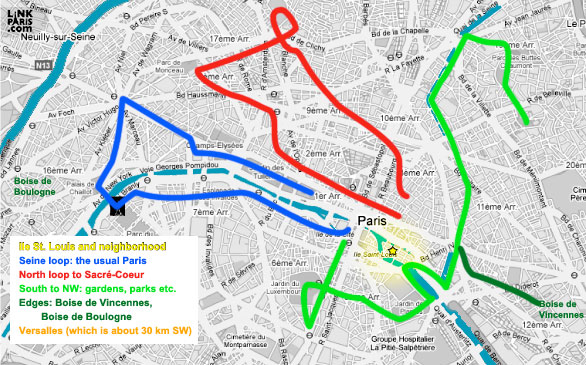 |
| The River Seine is the heart of the city. |
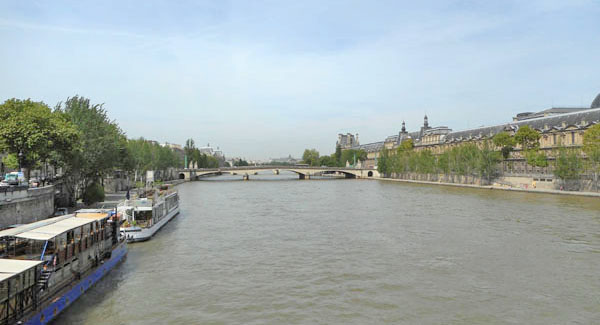 |
| We'd start out on early morning streets, usually trying to vary our route to explore new blocks we hadn't passed through before. Towards the end of the month this minor goal was getting a bit difficult... |
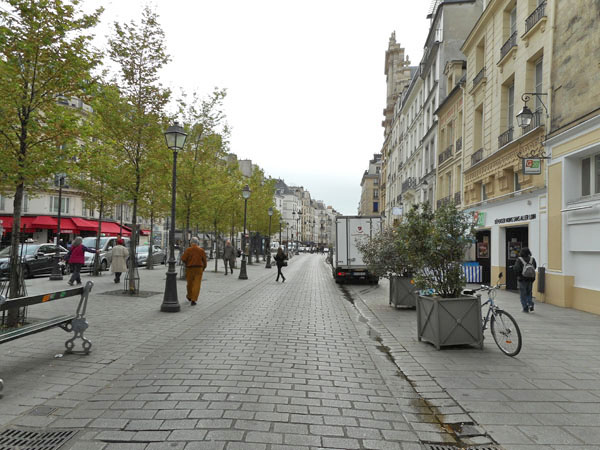 |
.. partly because we spent 20% of our days visiting the Musée du Louvre
|
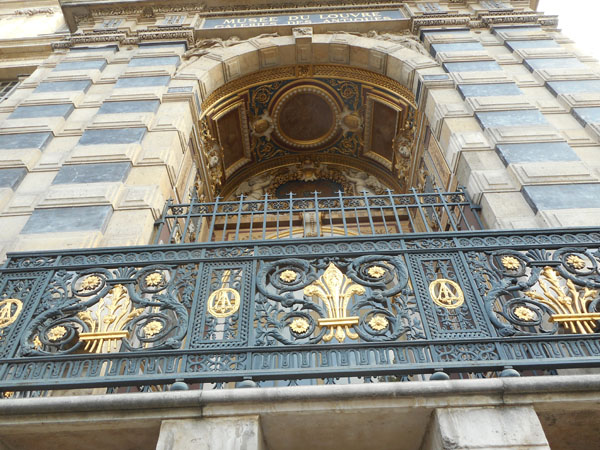 |
| The Louvre is ornate |
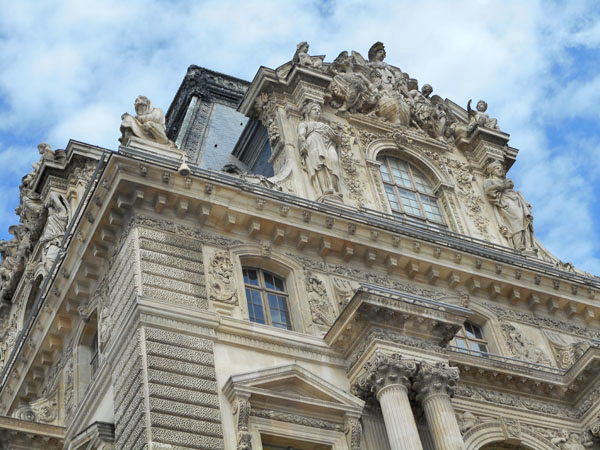 |
| And very large |
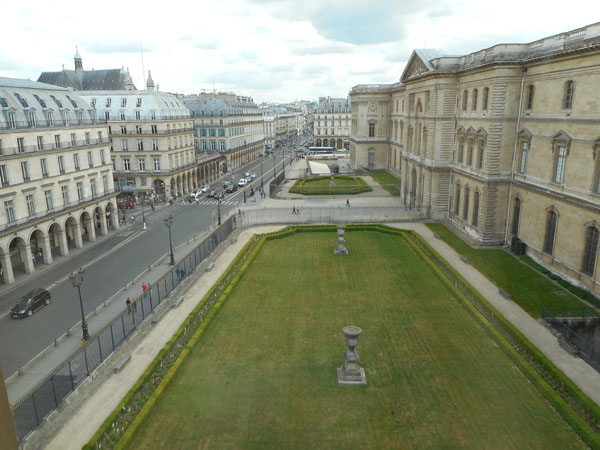 |
Did we mention Large? The previous photo has the two tiny green lawns marked by the black arrow at the far right... and 500 feet of the Louvre. The entire building (in red) is about 1/2 mile long... along each street. The famous Glass Pyramid is in the center of the Cour Napoleon. If you look back at the first Seine photo on this page, that's part of the Louvre occupying the entire right bank. |
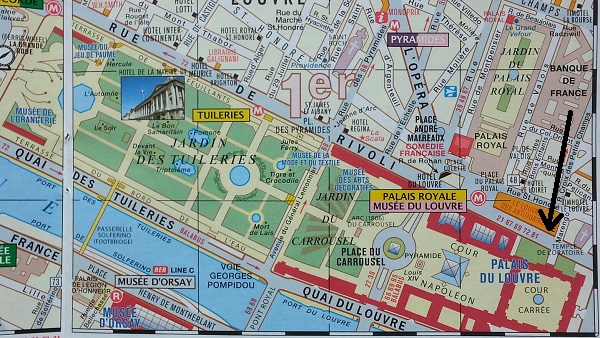 |
| there are several archways into the courtyards |
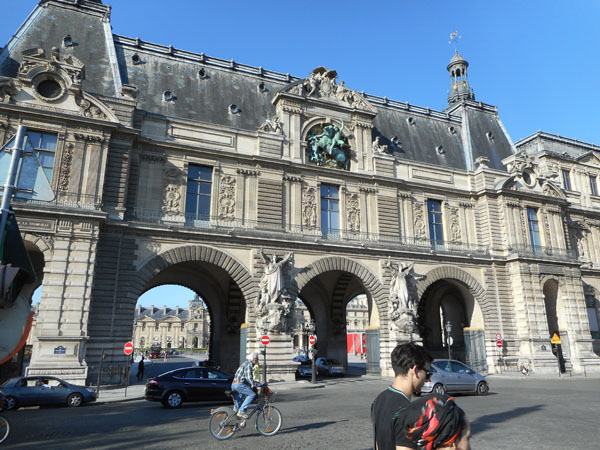 |
| Once in the first courtyard (Cour Caree) the scale (and ongoing maintenence effort) becomes apparent |
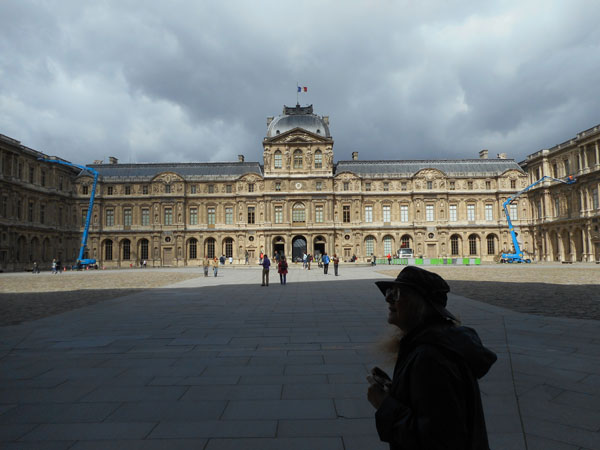 |
passing through the archway flanked by the lift trucks, we see more of the same impressive architecture here at the east end of Cour Napoleon |
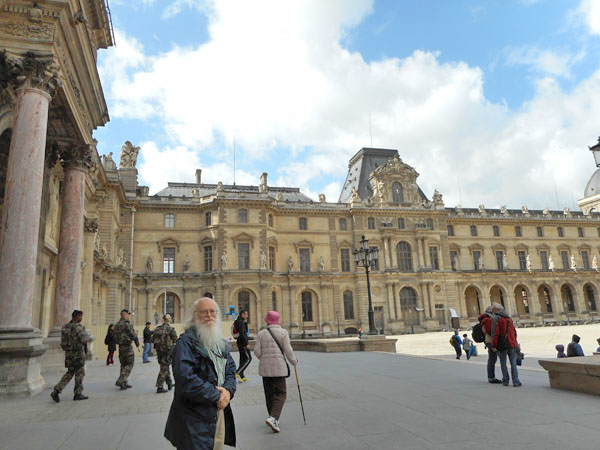 |
looking onward we see the entry pyramid |
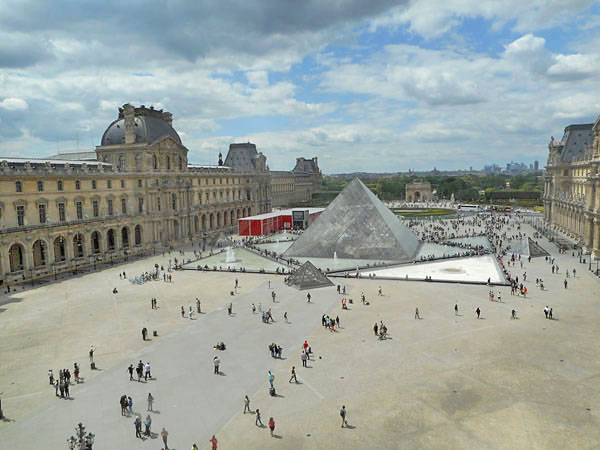 |
| getting closer we joined the zig-zagged lines for an hour... once. |
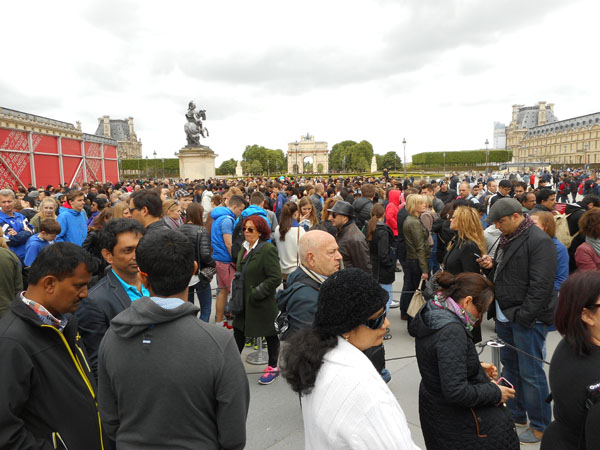 |
That first line only leads to a security checkpoint just inside the pyramid. Once inside we bought an 80 Euro family Amis du Louvre membership. That allowed us to bypass this entire long security line for a much shorter one (about 5 people). |
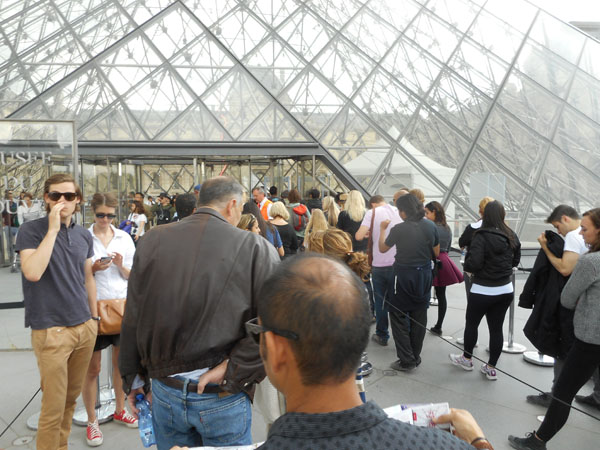 |
This end-of-the-day shot of the below-ground concourse shows empty cordoned areas for queing up to buy entry tickets. Most of the day they're very full. (the membership office had no line) Once here you are off to explore one of the several cross-connecting "wings". (click here to open another tab to see our version of the contents of this amazing museum. Use that page's navigation buttons or close it to return to this point) It took us five visits to walk the (we think) whole thing. They helped by having a few parts closed off. True story: on the fifth visit we were taking a shortcut to exit since we thought we'd seen everything... and discovered the entire Classical Roman section (how'd we (a) miss (b) forget about that??)
|
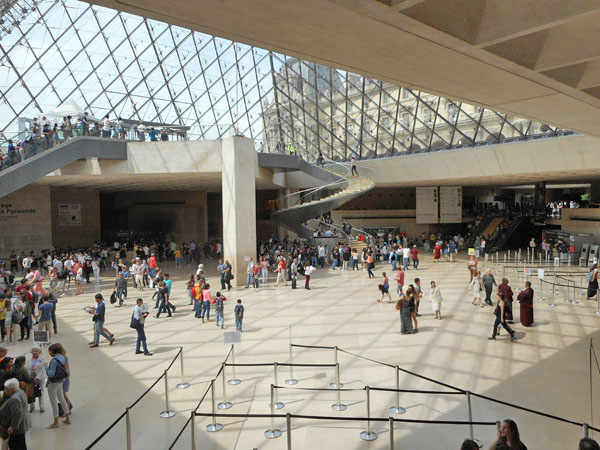 |
| You can also get into/out of the museum via an underground shopping center |
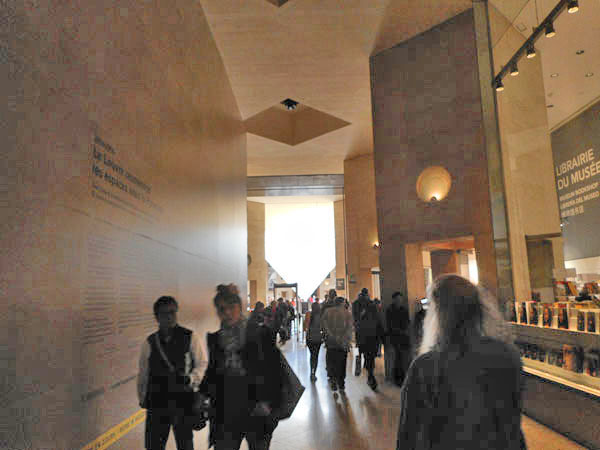 |
Which features an inverted pyramid.
(and an Apple store) (if you revisit the earlier map, this is the smaller pyramid located in the center of the traffic roundabout Place du Carrousel) |
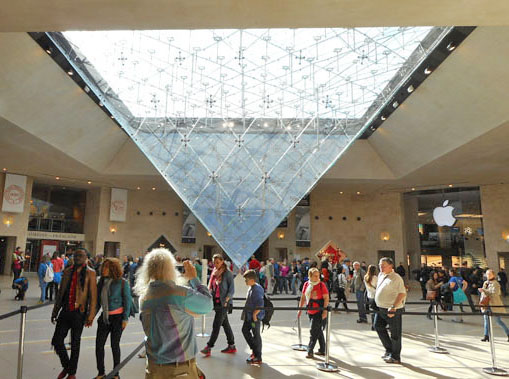 |
| There is also another museum in the northwest end of the palace: the Arts Décoratifs. We highly recommend it (click here to open a new tab to see inside it. Close that window to return here). |
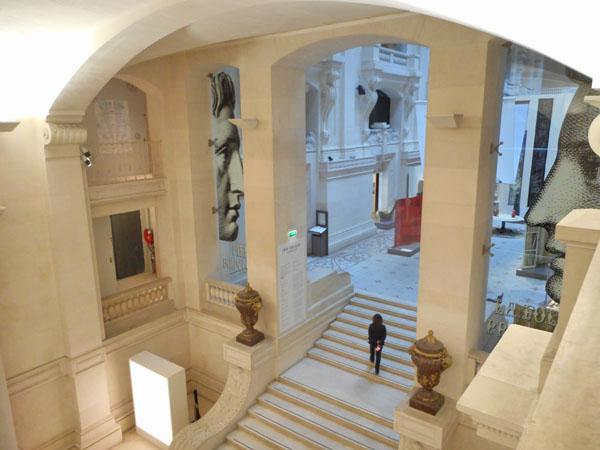 |
| Upon exiting the Louvre through the pyramid (just off view to the left) we cross the carrousel's roadway and head for the arch. |
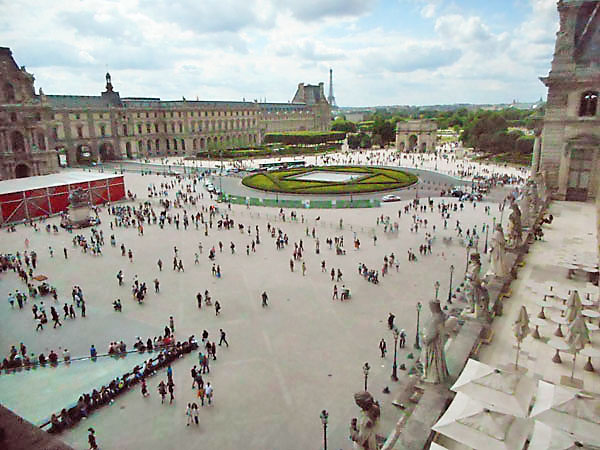 |
| This is the Arc de Triomphe du Carrousel (we'll get to the "real" Arc de Triomphe de l'Étoile at the other end of this broad swath of park, up a long avenue and about 30 more pictures...). |
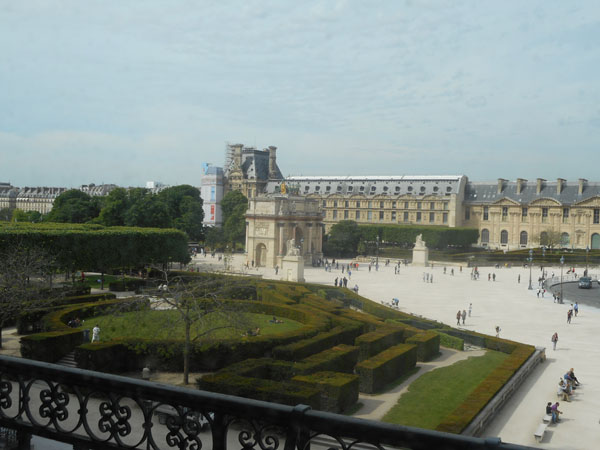 |
It is impressive but not as large as the "real" one.
(Yes, that's Napoleon up there) |
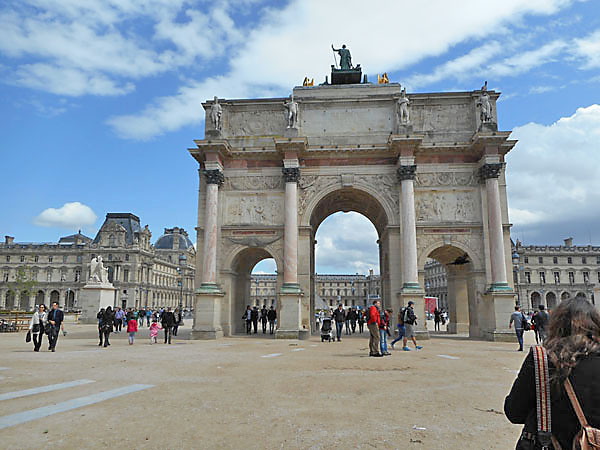 |
| And it marks the eastern end of the Tuileries, the Louvre's grand and well-used gardens. |
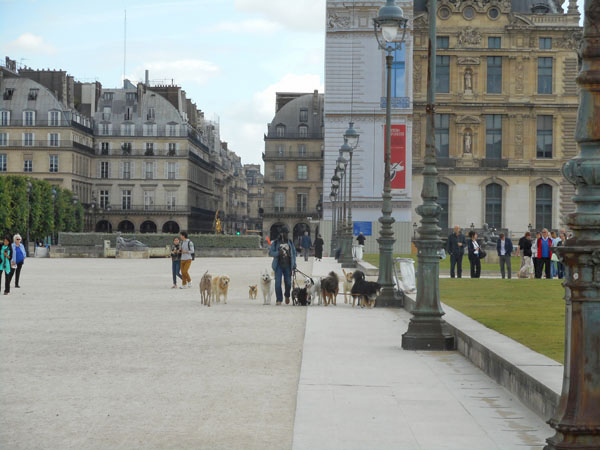 |
| Full of statuary, vast lawns and man-made lakes, |
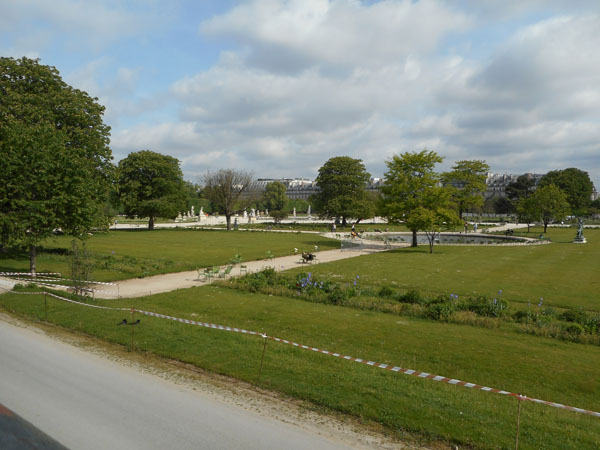 |
| sculpted plants, |
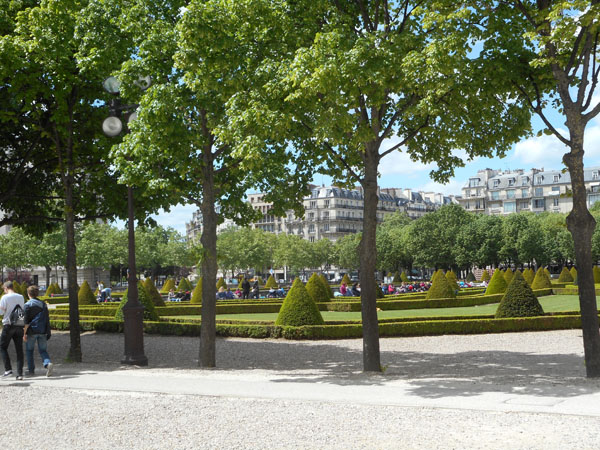 |
| with hard-working assistant grounds keepers. |
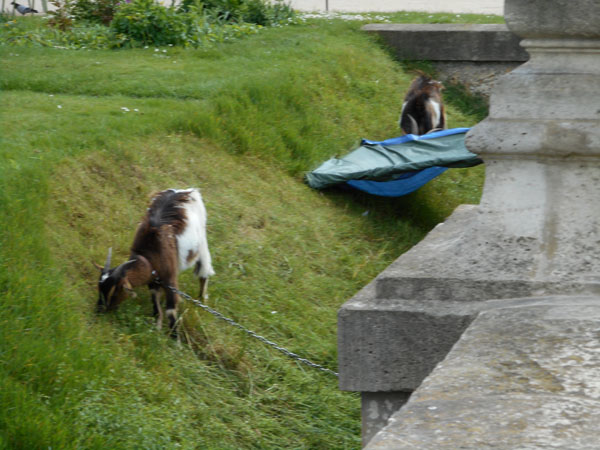 |
| In one corner was a very Parisian pop-up art/commercial pavillion. It was selling body-care creams. |
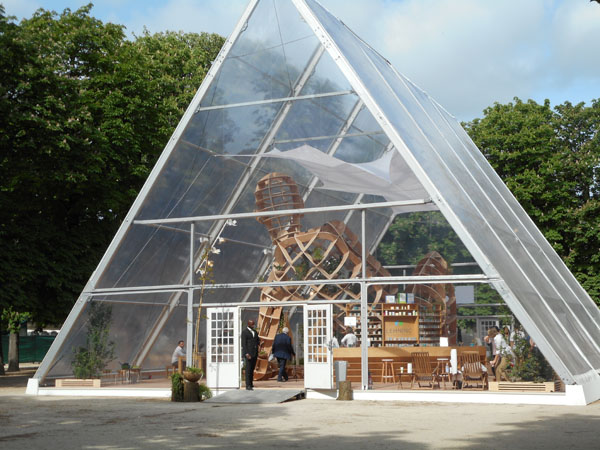 |
| At the west end of the Tuileries we find the Orangerie, a greenhouse turned Impressionist museum. Renoir, Cezanne, Picasso, Matisse and beyond. |
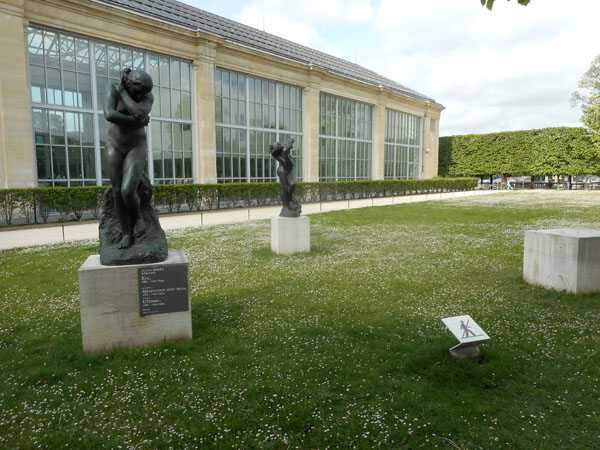 |
| And featuring two purpose-built rooms to display Monet's willows and waterlilies "in the round", as originally intended. |
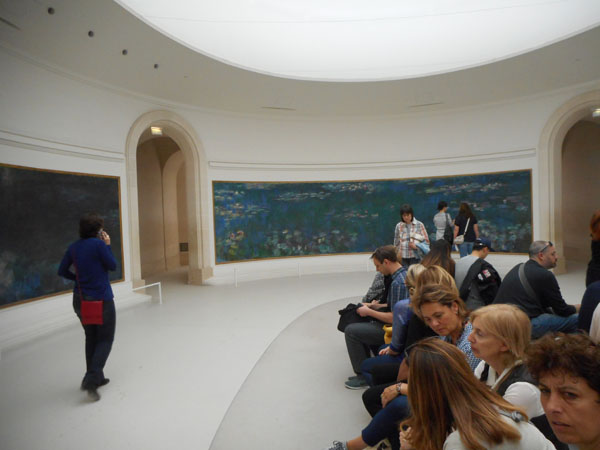 |
| |
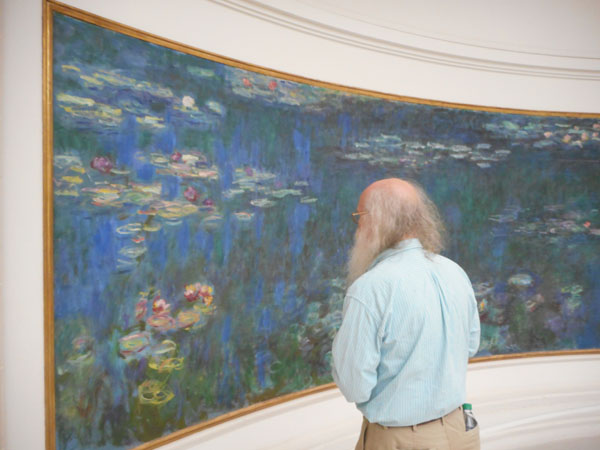 |
| if you get close the illusion becomes broad strokes of paint, entrancing in their own way. |
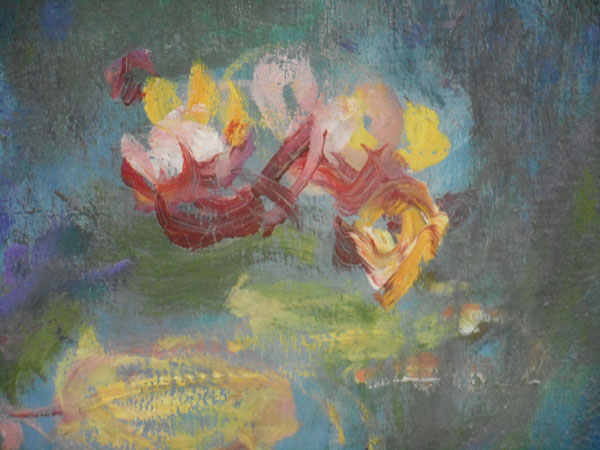 |
The west end of the Tuileries, looking north. The Orangerie is behind us, and hidden by the hedge at the far left is the Musee du Jeu du Palme... or "tennis court". Like the Orangerie, it retains the name of the building's original purpose... but now it's a museum of modern and post-modern photography. |
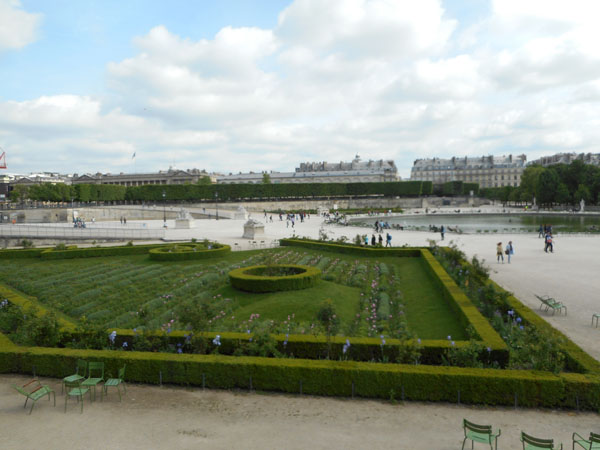 |
| The west exit from the Tuileries leads to the Place de la Concorde |
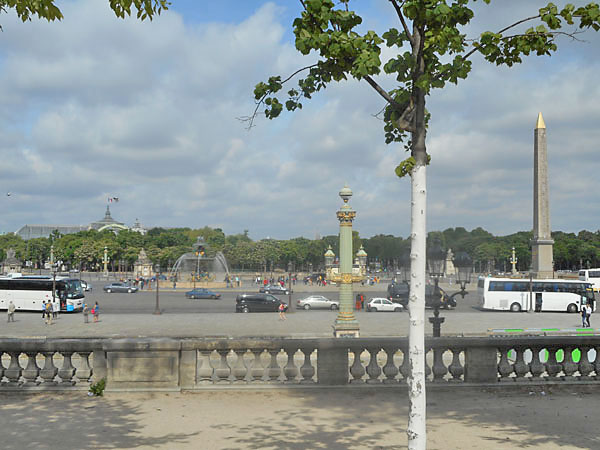 |
| With its Egyptian obelisk. Not one of Napoleon's souveniers, it was a gift from Egypt's post-Napoleonic ruler to King Louis-Phillipe. The inscriptions around the base outline the boat trip and erection details. The cap was gilded in 1998. |
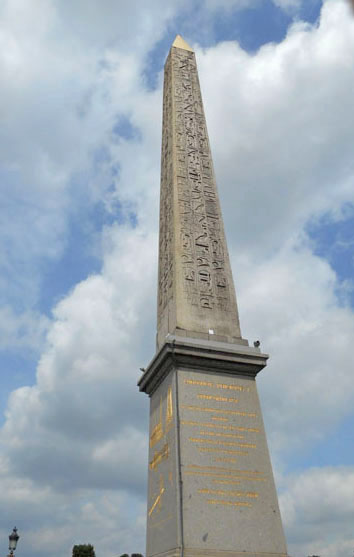 |
| The twin flanking fountains feature women squeezing fish |
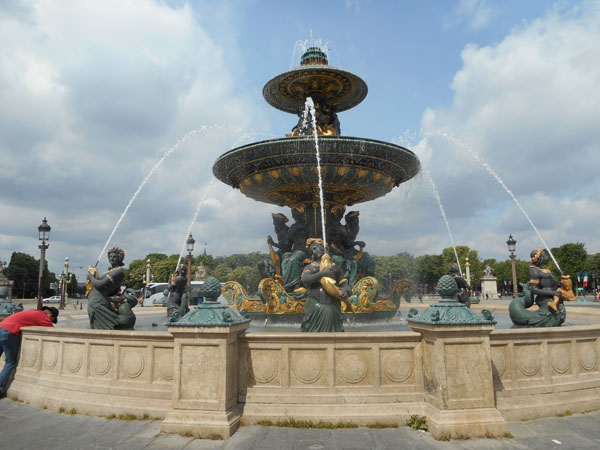 |
Next along the Seine, we came to the Grand Palais, constructed for the Universal Exhibition of 1900. Now used for special exhibits. Here it is seen from across the river |
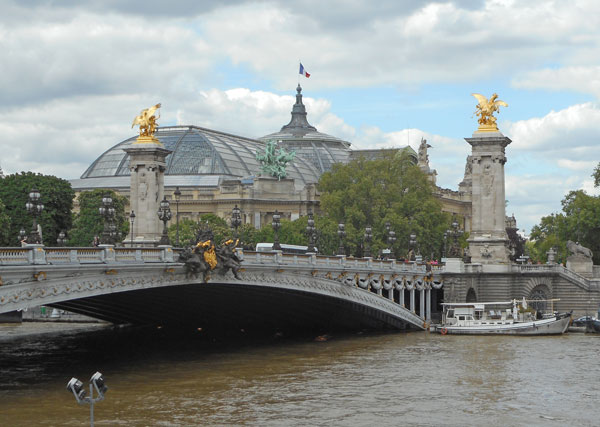 |
| The Grand Palais' quiet corner entrance to its restaurant. |
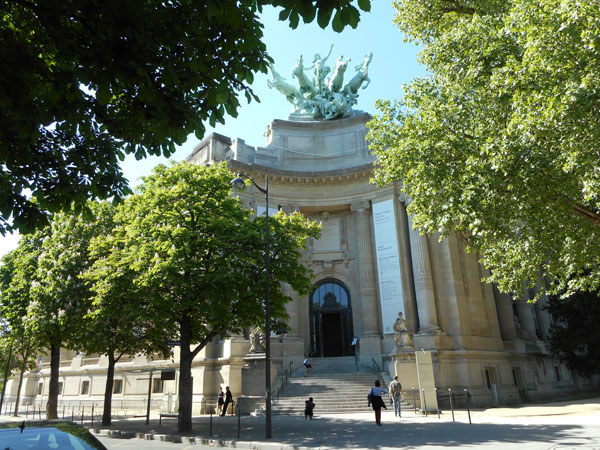 |
| A very grand building |
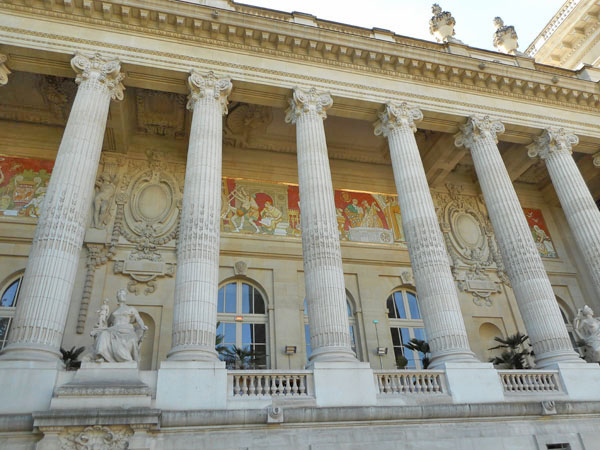 |
| with matching entryway... |
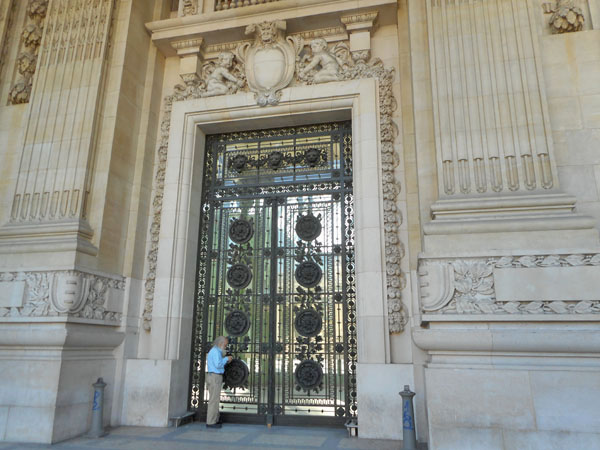 |
Yes, still used for expositions but mostly empty during our visit.
(somehow we never found time to visit the west end of the Grand Palais, which contains the Palais de la Découverte, a science museum) |
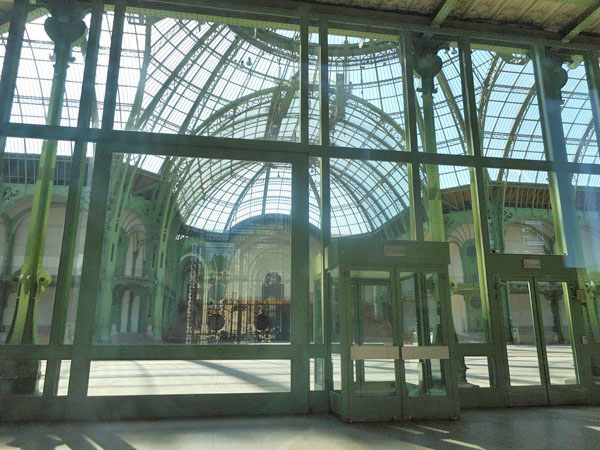 |
| Across the street stands The Petite Palais |
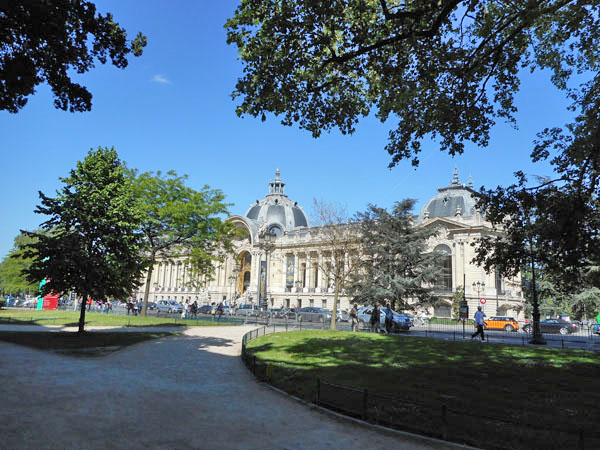 |
| "Petit" only when compared to the "Grand", it houses a small city museum of things from mostly the art deco/art nouveau periods |
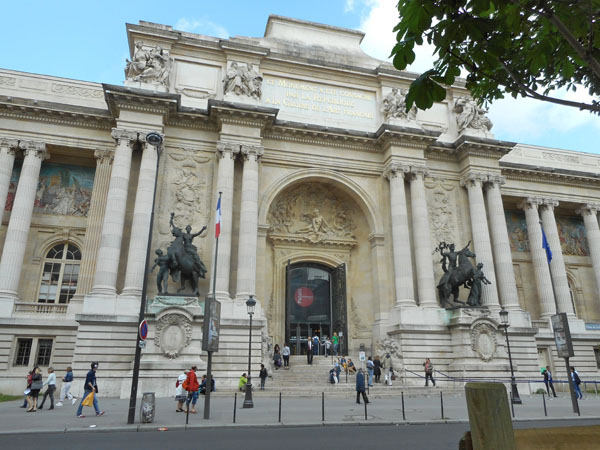 |
| Another grand building to explore |
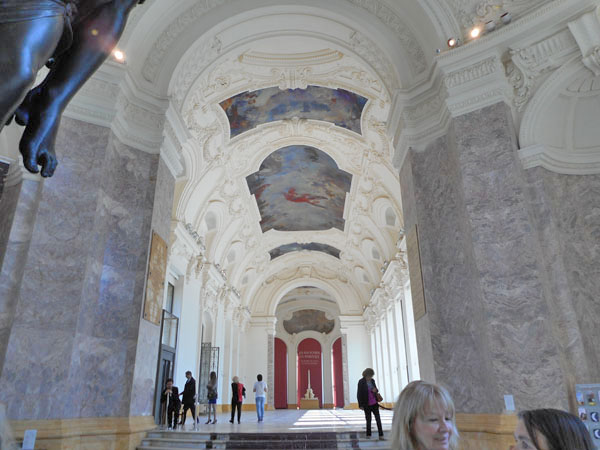 |
| with inlaid floors |
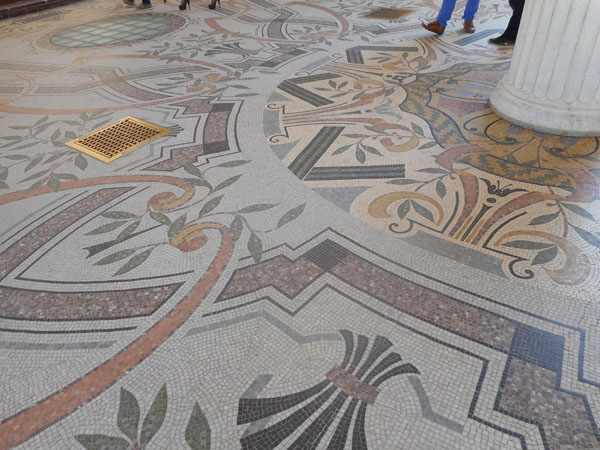 |
| and painted ceilings |
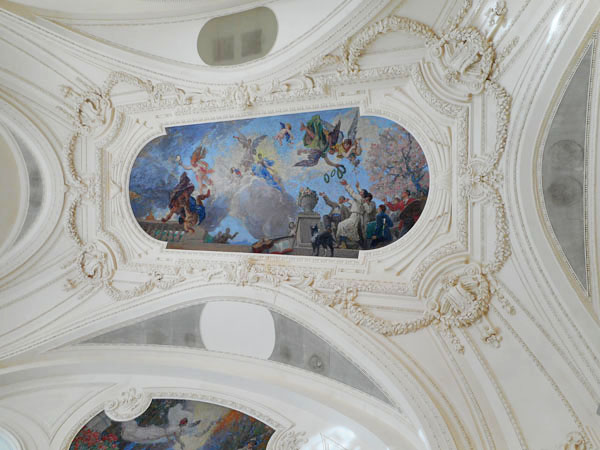 |
| |
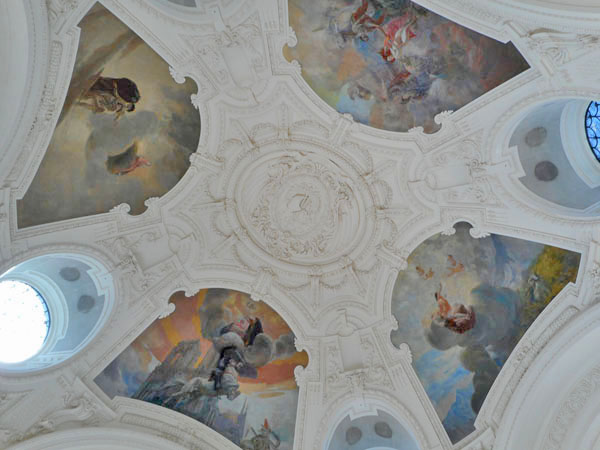 |
| They had some very nice glass |
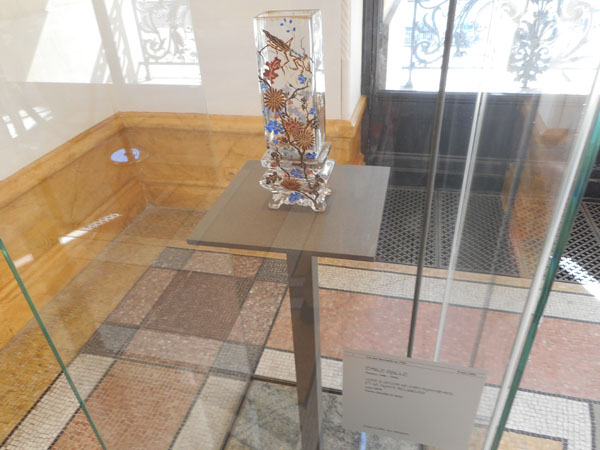 |
| more glass |
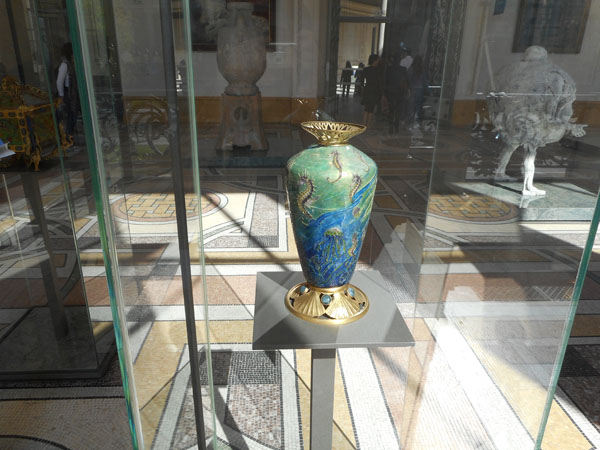 |
| metal |
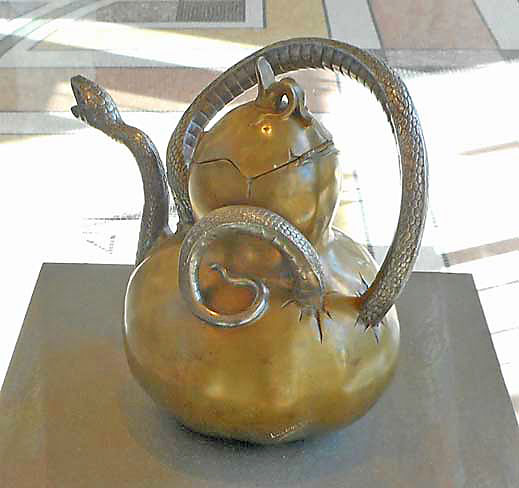 |
| some wood, including a whole paneled room |
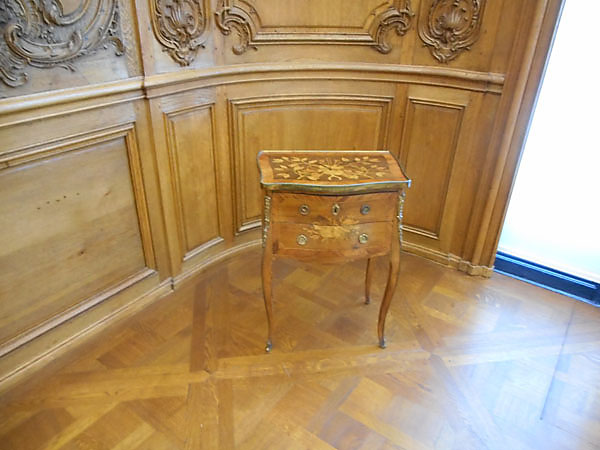 |
| some lust-inspiring difficult-to-photograph jewelry |
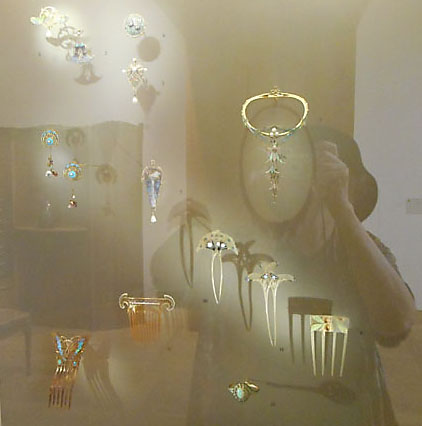 |
| And interesting statues |
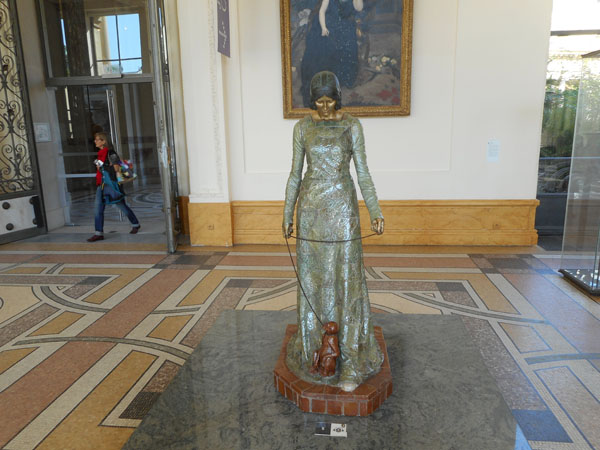 |
| |
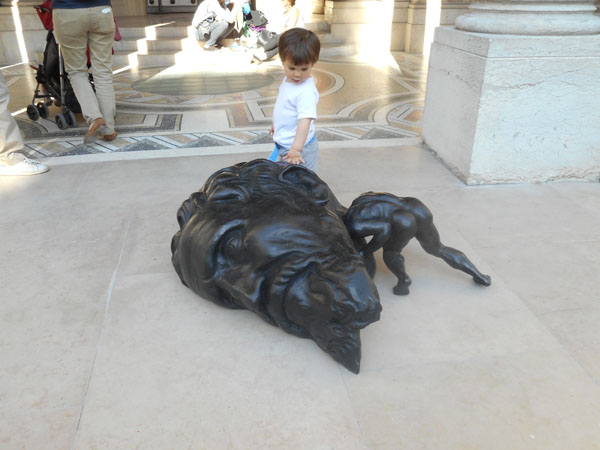 |
| For Karen the high point was the tropical-feeling oasis inside |
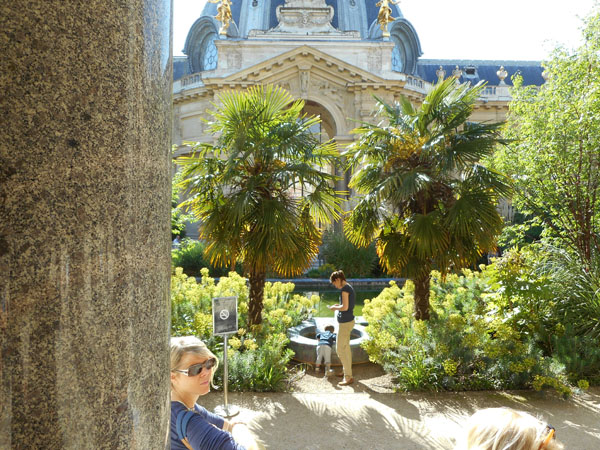 |
| with a pool rimmed with iris mosaics. |
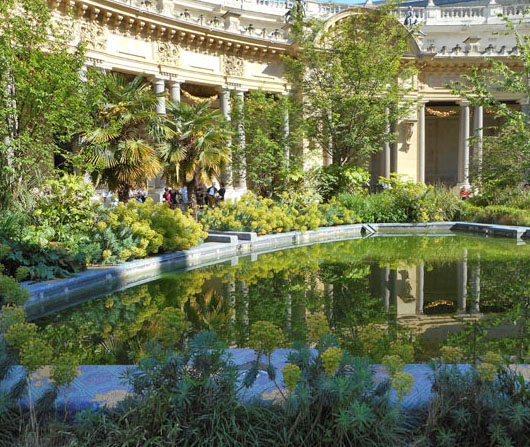 |
| Leaving the Petite Palais and following the Champs Elysees west we came across Boy Scouts in full camp mode. We're not really sure about where they were heading. |
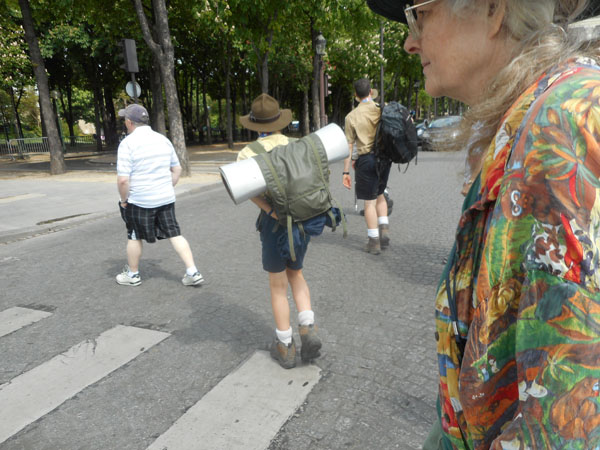 |
Walking along, we came across a front yard with this bear (bearing something?).
It was the German embassy.
The bear is decorated to celebrate the 50th anniversary of the Élysée Treaty between President Charles de Gaulle and Chancellor Konrad Adenauer. Dick noticed that the bear could have been stood on its front paws if the occasion warranted, Karen noted that it was one of the rare "not a nude" sculptures we encountered that day. Neither of us knew "Why a bear?"
Researching for this text, we found the Buddy Bear charity project... |
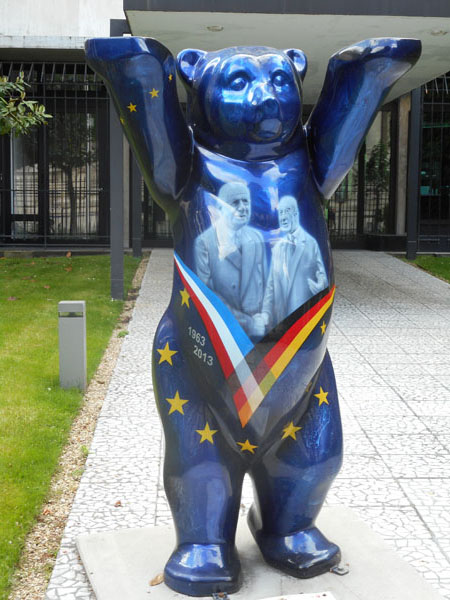 |
| And several other courtyards also had interesting sculpture and building fronts |
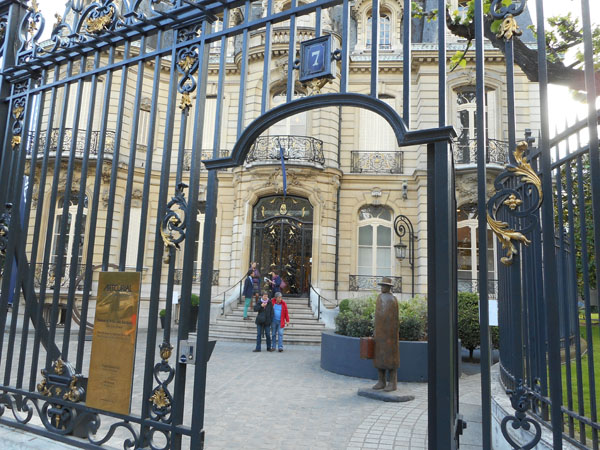 |
| Marching up from the Tuileries put us on the Avenue des Champs Elysees with its sculpted trees. Here we're looking back along our route |
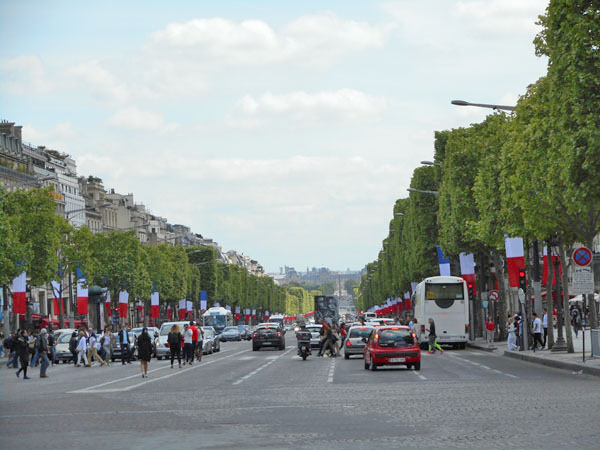 |
And forward to the "real" Arc de Triomphe.
The Champs Elysees was known for its very hoity-toity shops and well-dressed wealthy folks strolling the boulevard. A few down-market elements have crept in. (There is still a multi-storey Mercedes dealership). |
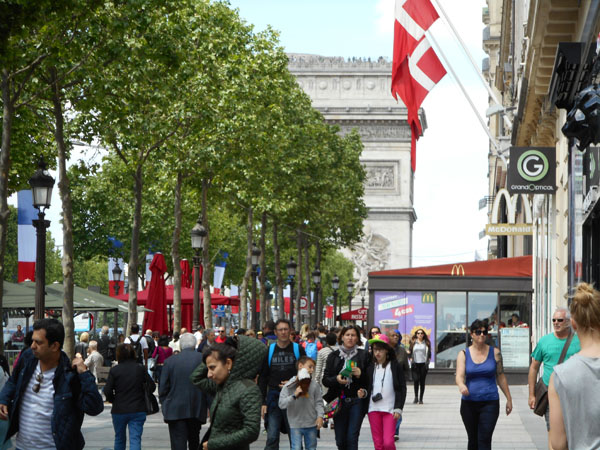 |
| The Arc de Triomphe de l'Étoile is in the middle of a massive traffic circle |
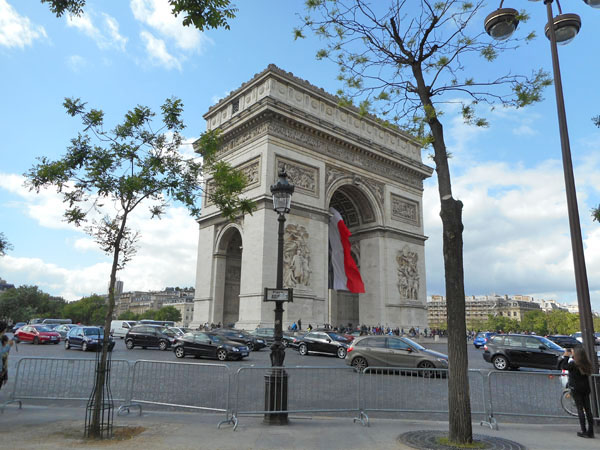 |
| Pedestrians reach the Arc via a tunnel |
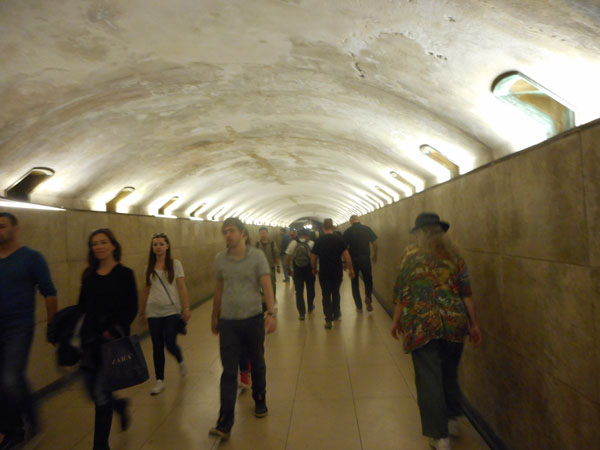 |
The Arc began life as a tribute to Napoleon's conquests. He's on the left receiving a laurel crown. We ran into what appeared to be a travel or news video being filmed |
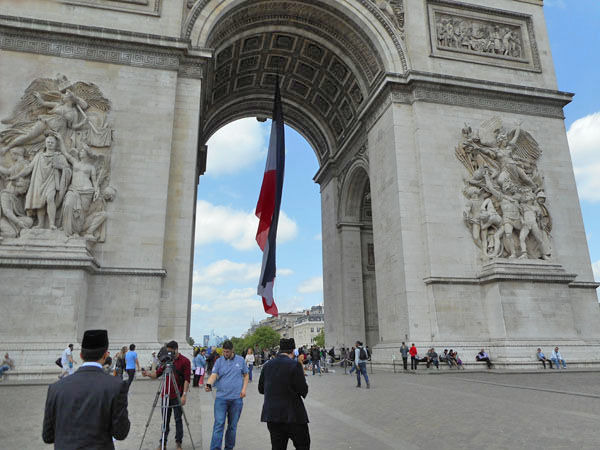 |
| The Arc is a war memorial |
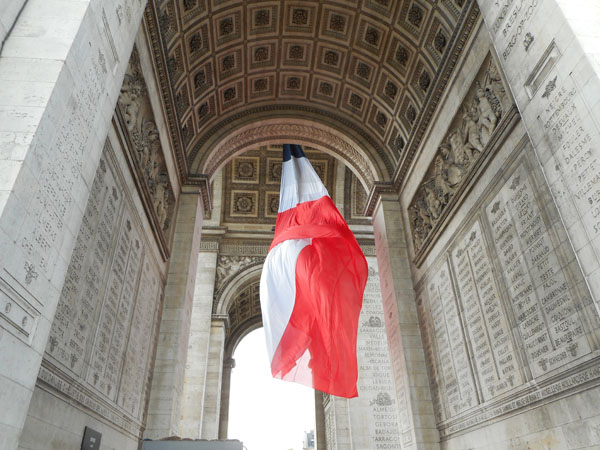 |
with France's unknown soldier and eternal flame. In the faint distance is Paris' newest arch: the Grande Arche de la Defense. |
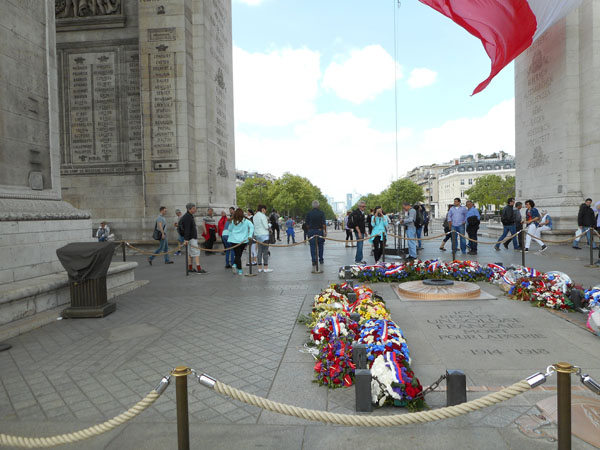 |
| From the Arc de Triomphe, we head downhill and south to return to the Seine. As usual, the walk leads us past interesting buildings |
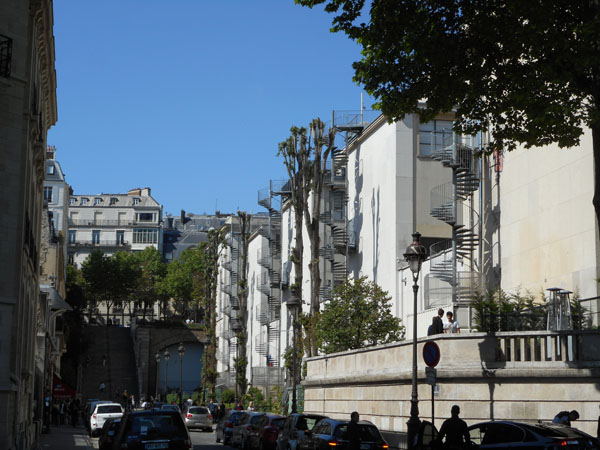 |
| as well as a street market |
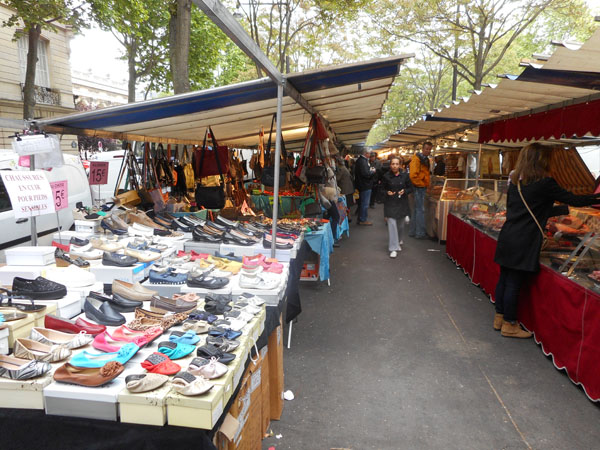 |
| until we come to George Washington. |
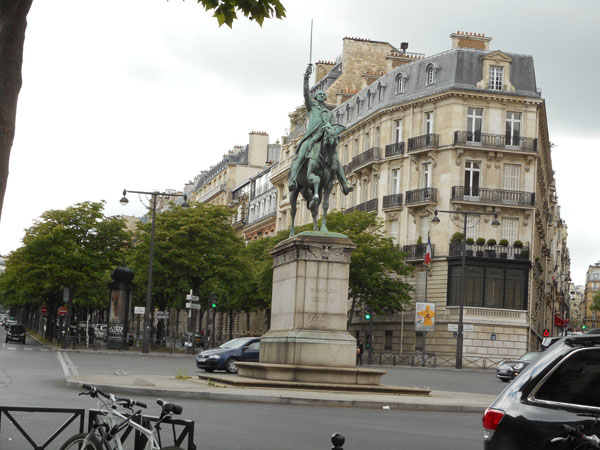 |
| Facing George's left flank is the Guimet Museum, the national Asian art collection. (Click here to see what's inside, close that window to return here.) |
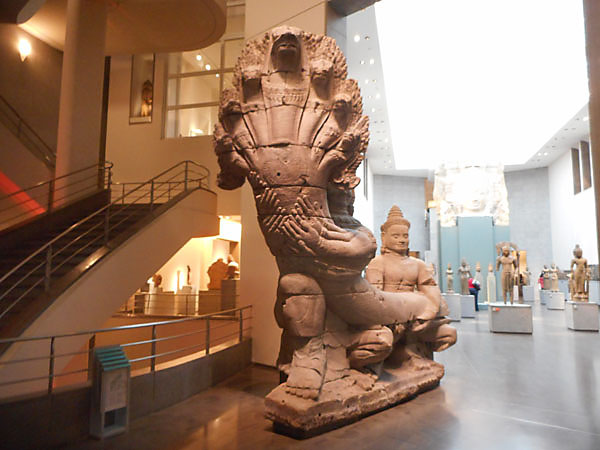 |
| There are several other "palais" in the same area but we didn't visit them (this is the Palais Galleria, housing the Musee de la Mode et Costume) |
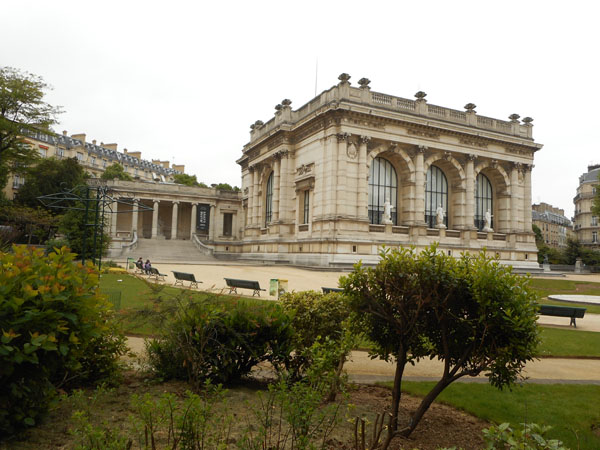 |
| The Palais de Tokyo, housing the Musee d'Art Moderne de la Ville de Paris. |
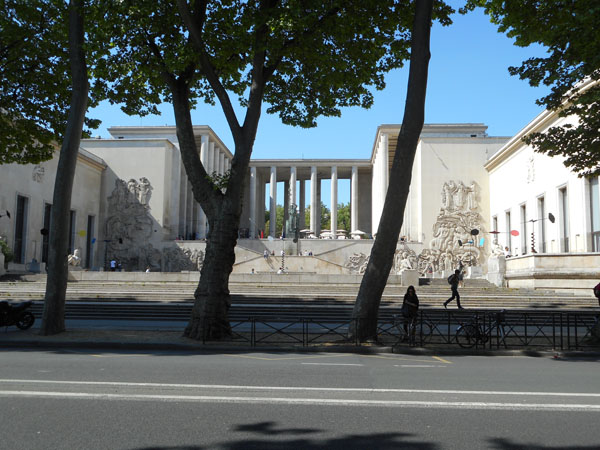 |
| This entrance to the Cite de l'Architecture et du Patrimoine (housing entire buildings) also marks the turn to the plaza ... |
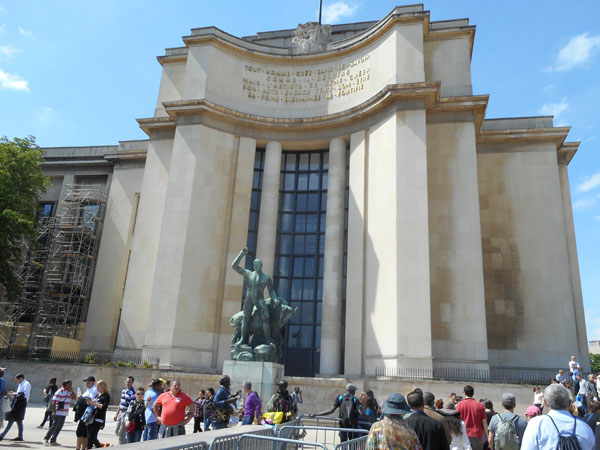 |
| overlooking the Trocadero fountains, with Eiffel across the Seine. |
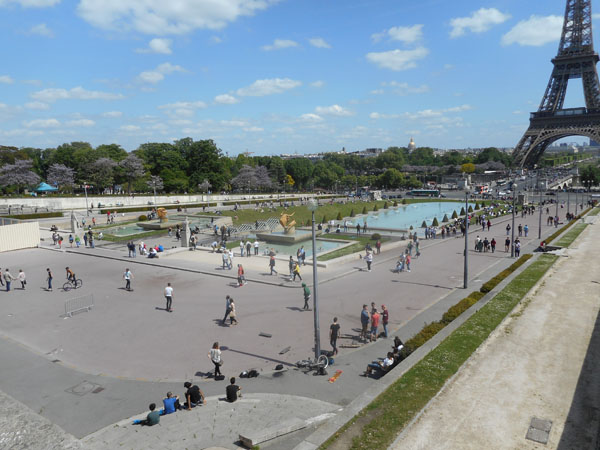 |
| There was a speaker and crowd at the top of the plaza |
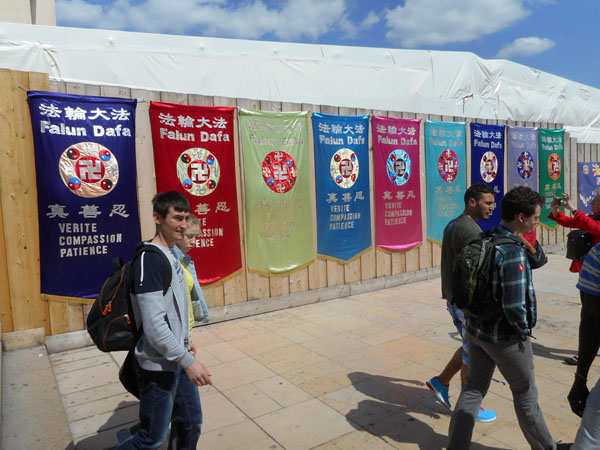 |
| But most folks were there to see the fountains cycle and enjoy the sun |
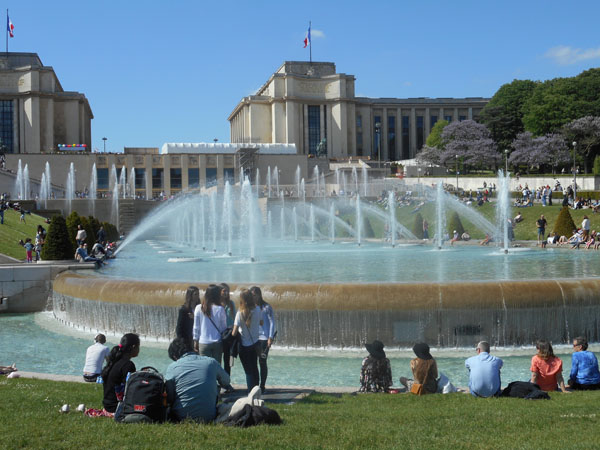 |
| The ever-present wedding photos being taken |
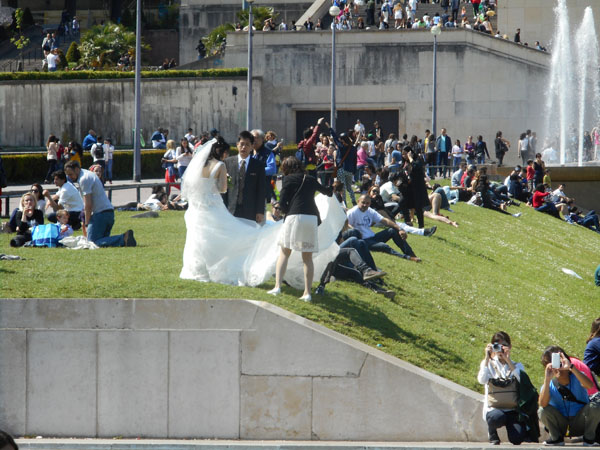 |
| Here we cross the bridge to the Tour Eiffel |
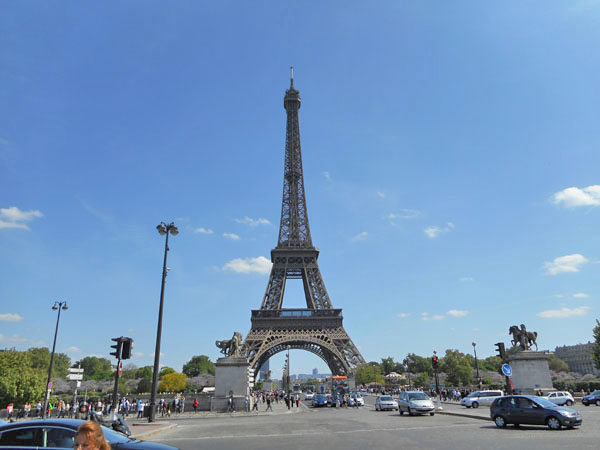 |
| We never realized it was bronze colored. Nor that there are names of 72 famous scientists, engineers and mathematicians along the edge under the first level |
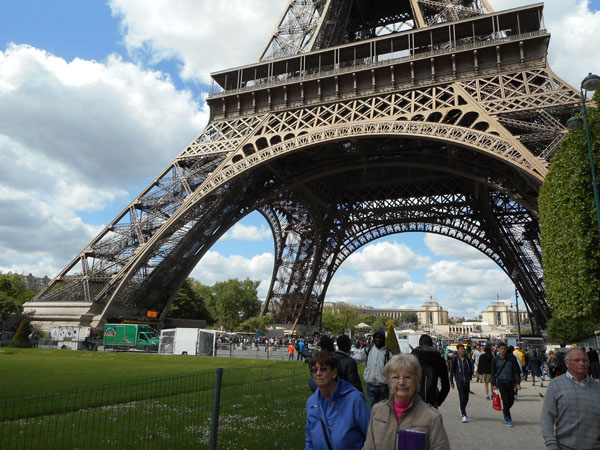 |
| We had already agreed that climbing the tower wasn't a "must do" for us. As expected, there was quite a line for the elevator. |
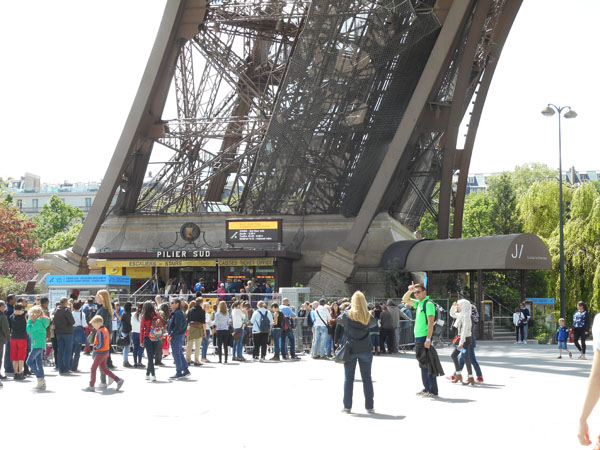 |
Instead (on a different, rainy, day (note cowering visitors)) we went across the street to the Quai de Branley. Another digression on Parisian Museum naming conventions: sometimes they're named for the building they're in (like the Orangerie and Jue de Paume), sometimes for what they hold (Monet, Picasso), and sometimes, in this rare instance, they're named for the street that they're fronting. Any street name that starts with "Quai" borders the Seine. |
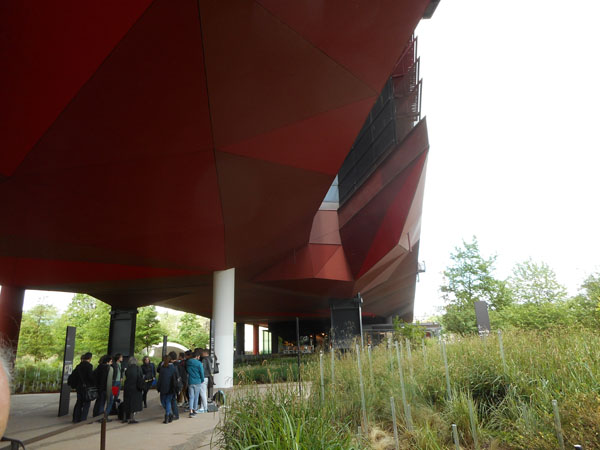 |
| The Branley's entry is a long spiral ramp covered with moving words that takes you from ground level up into the elevated main body of the museum (Click here to see some of the indigenous art this fine museum holds. Close that window to return here) |
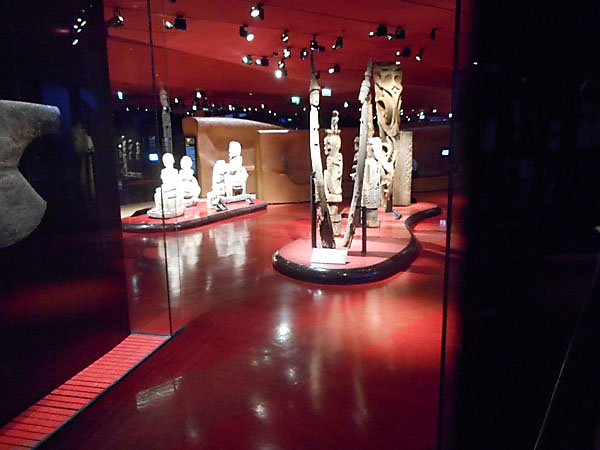 |
| Exiting the museum on the non-Seine side, we went through interesting neighborhoods. (The Seine-side photos are on our "neighborhood" page). |
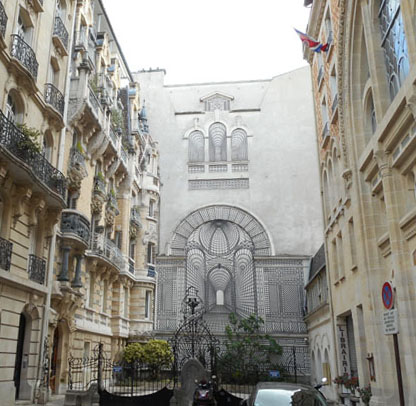 |
Rick Steves' Paris guidebook speaks very fondly of nearby Rue Cler. An artisan boulanger is a baker who creates and bakes their wares on-site. |
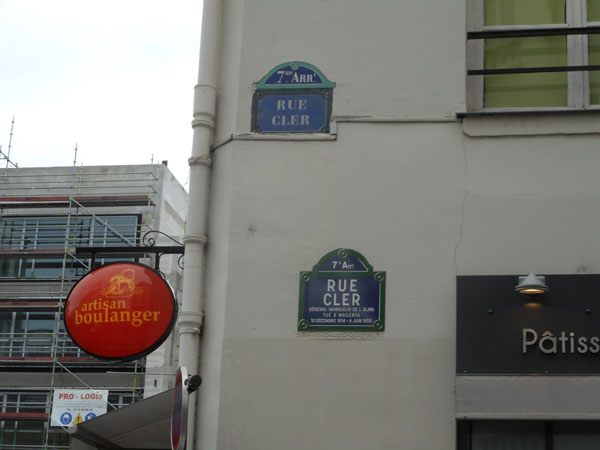 |
| Rue Cler is obviously well-equipped for tourists and families. |
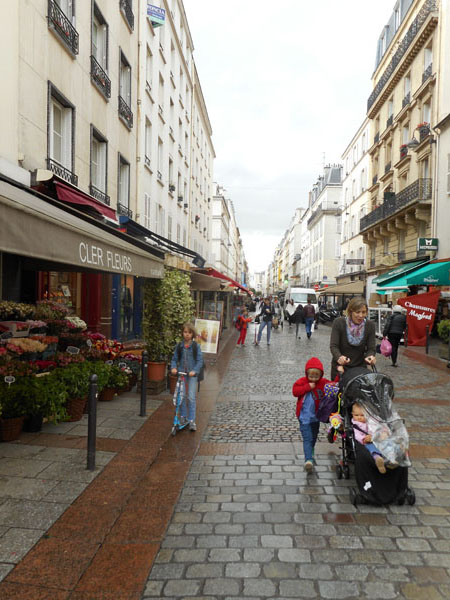 |
| We even found a raincoat (and palmier pastry) for Karen who wasn't looking forward to a wet walk home in a sudden downpour (Dick had worn his rain jacket even though it meant carrying it through the museum). |
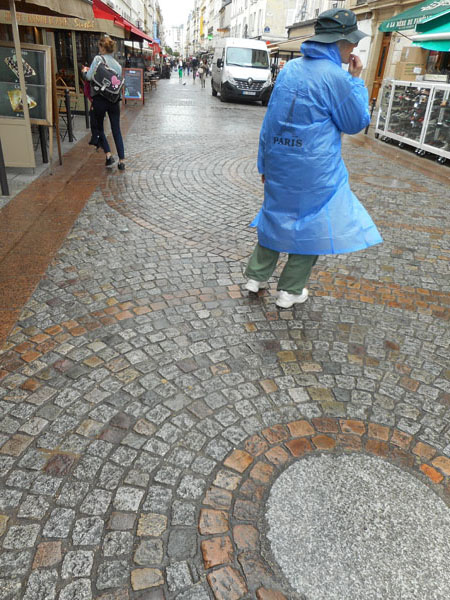 |
| Interesting stonework... |
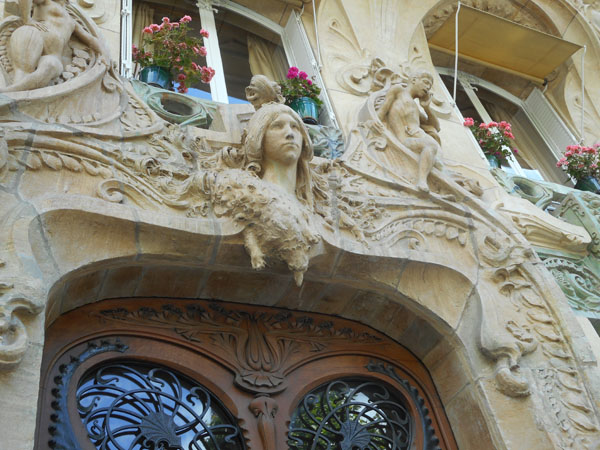 |
...above an interesting door.
One of us shot the bottom and the other the top, neither had a good photo of the whole door. Teamwork! |
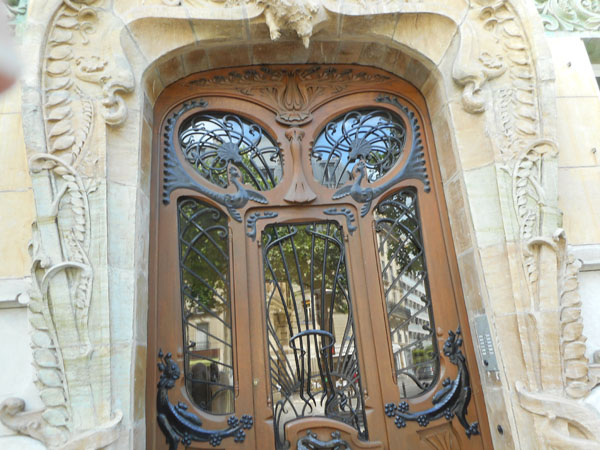 |
| Then we come to a large building... |
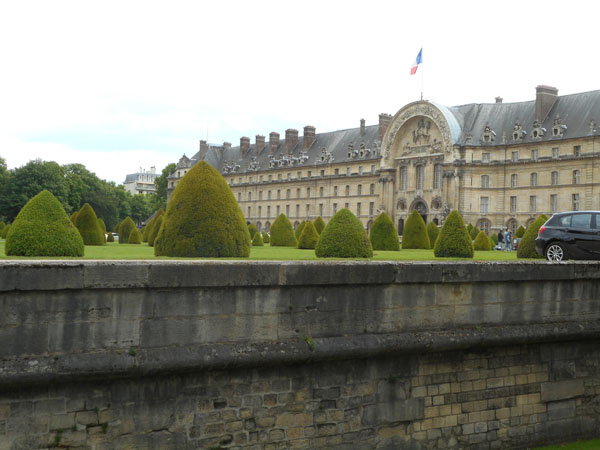 |
| with moat and cannon. It is the Invalides Hospital, Army Museum and (tucked in the back) a church and Napoleon's tomb. |
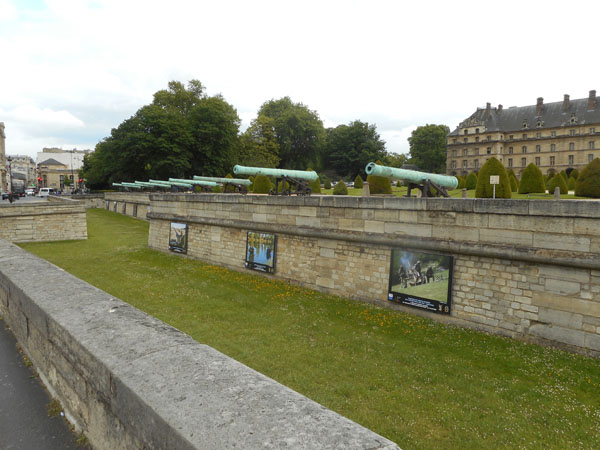 |
| Preparations for the next day's VE celebrations were underway. |
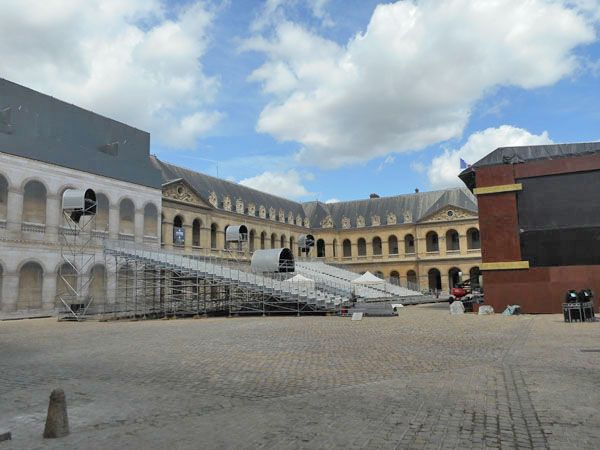 |
| Louis XIV commissioned the hospital and cathedral in the late 1600's.
Here is the fairly plain and functional Veterans' Chapel.
|
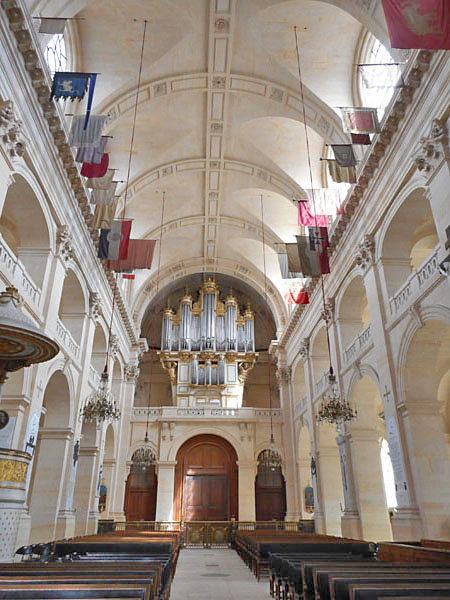 |
| Looking towards the Veterans' altar. Note the clear window behind the altar. |
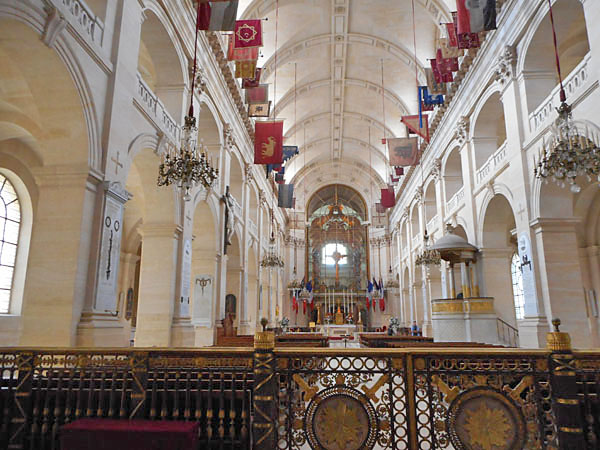 |
| On the other side of the altar's clear window is another church, the Eglise du Dôme... a far grander chapel which Louis XIV prepared for himself before the first was finished. |
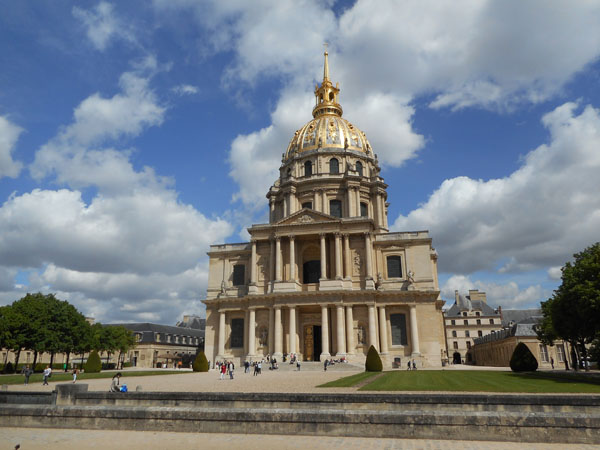 |
The window of the first church looks into this more ornate altar and chapel.
This allowed the soldiers to attend church "with" their King. They were in the plainer church, he was here in the Royal Chapel. Then 120 years passed. In 1800 Napoleon turned the royal chapel into a pantheon to hold the bodies of famous French Marshals. |
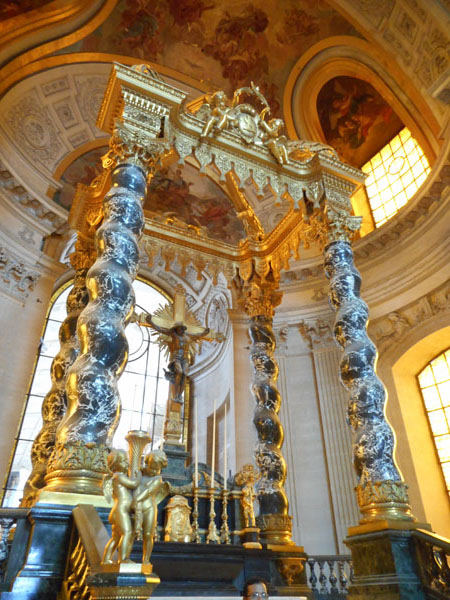 |
| The Kings' and Napoleon's building frenzies kept lots of French craftmen employed |
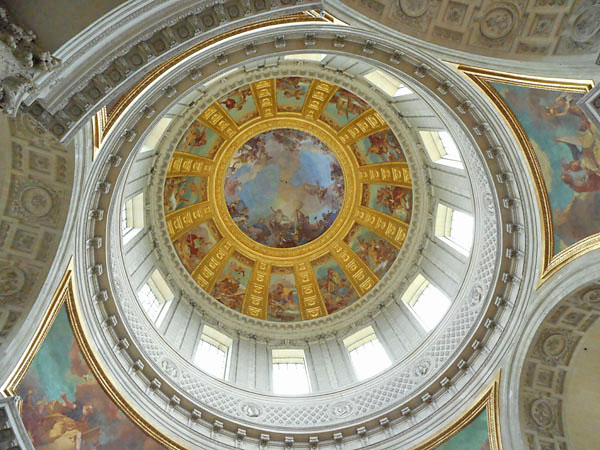 |
| Buried here are Napoleon's son l'Aiglon, the King of Rome, his brothers Joseph and Jérôme Bonaparte, Generals Bertrand and Duroc, marshal Lyautey... |
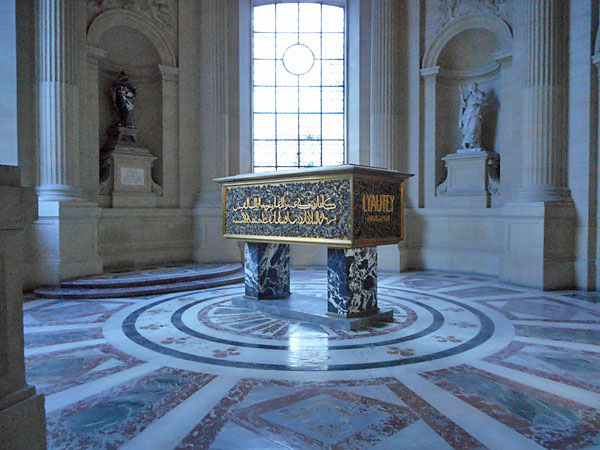 |
| and Marshal Foch. |
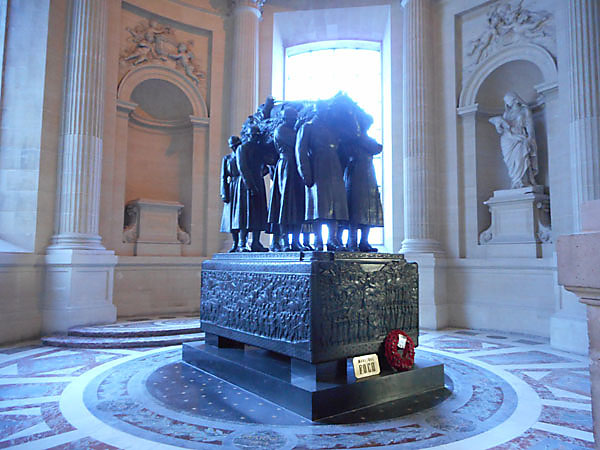 |
| But the pièce de résistance is back in the Royal Chapel area... the tourists are looking over a railing down ... |
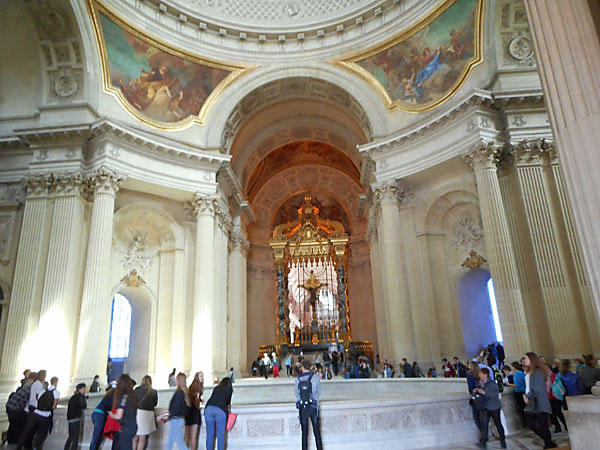 |
...to the crypt containing Napoleon's tomb itself.
King Louis-Phillipe arranged for the body to be transferred to France, but by the time the tomb was completed France had gone through another revolution (bringing the 2nd Republic into power), elected a President: Louis-Napoleon Bonaparte, who staged a coup d'état and was reigning as Emporer Napoleon III when Napoleon I's body was finally interred here. |
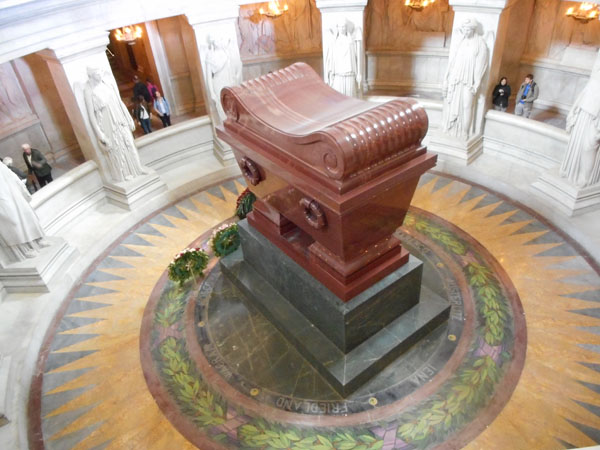 |
| Twelve sculpted "Victories", symbolizing his military campaigns, surround the coffin. |
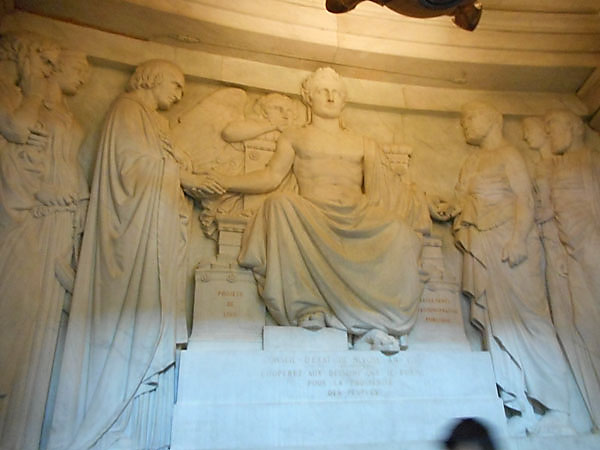 |
We surface from the splendor and return to the left bank of the Seine.
The next stop along our way is a very grand old train station |
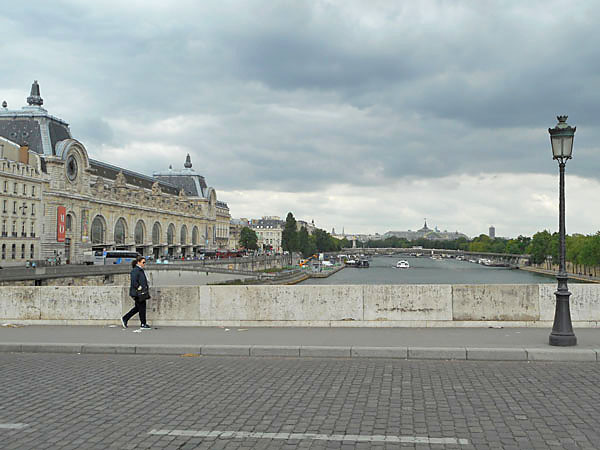 |
| ...which houses the Musee de Orsey. The clock faces |
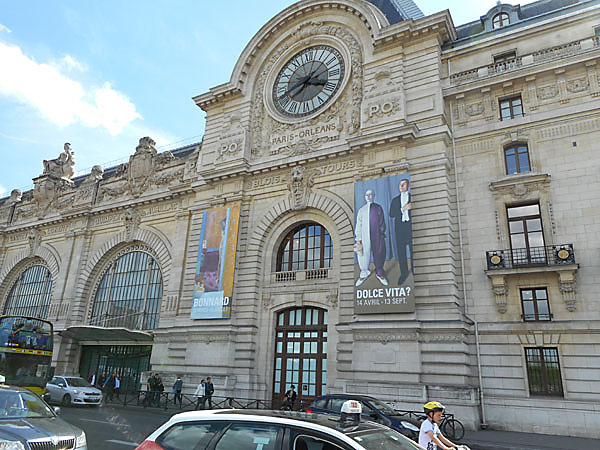 |
| are transparent and accessible. |
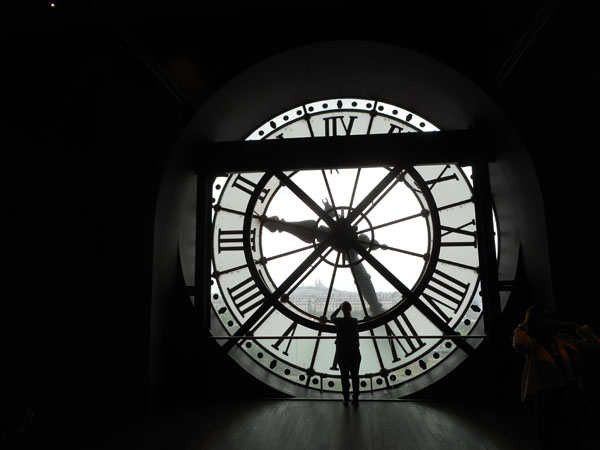 |
| Fun sculptures ring the entrance |
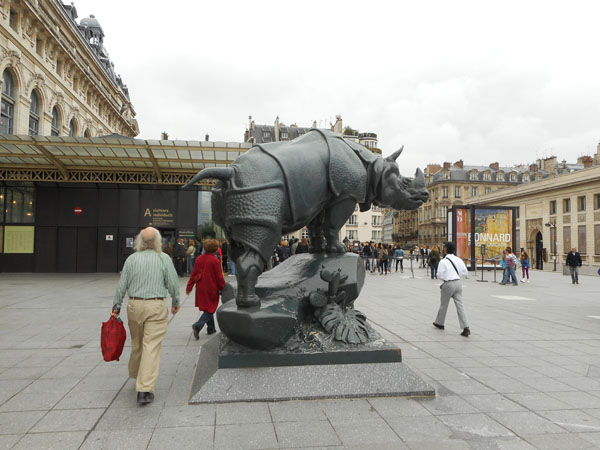 |
| later looking out we were glad we arrived early. Branch here to see the highpoints (or at least those in focus) of our "ordeal de Orsey". Close that window to come back here |
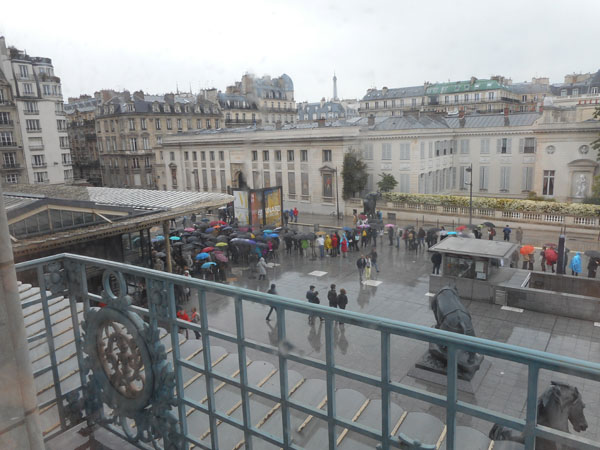 |
| further east we stumble upon the French Acadmie of Science |
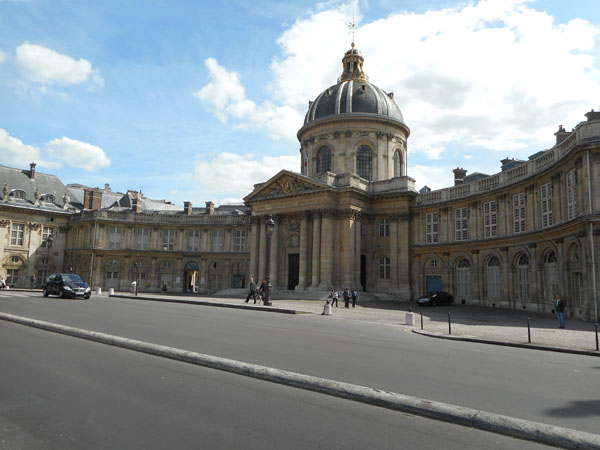 |
| And the Taschen bookstore |
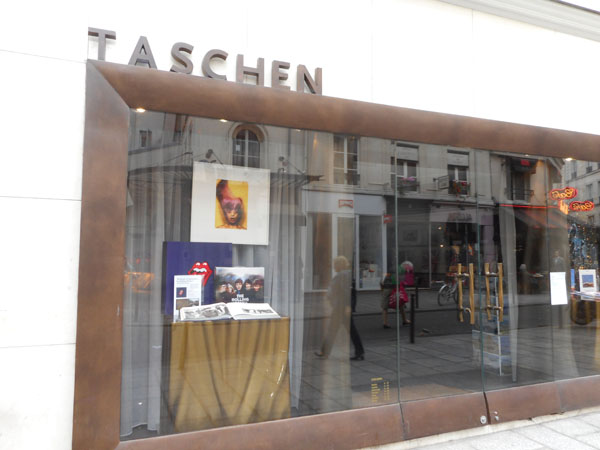 |
| If you had eaten at the Orsay, you'recognize the tables in the local shop. They also carried the bell shaped lights |
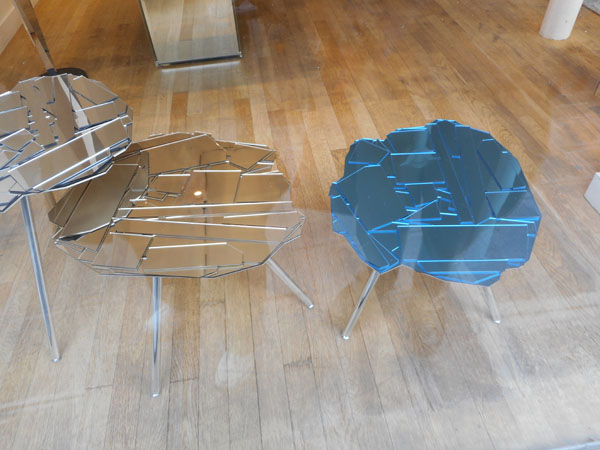 |
| an interesting screen |
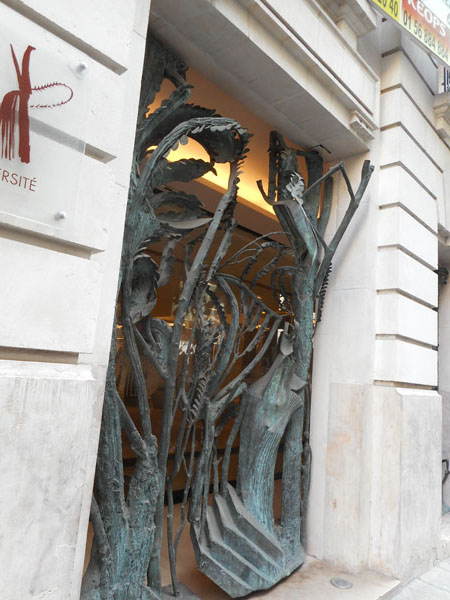 |
| and another fun doorway |
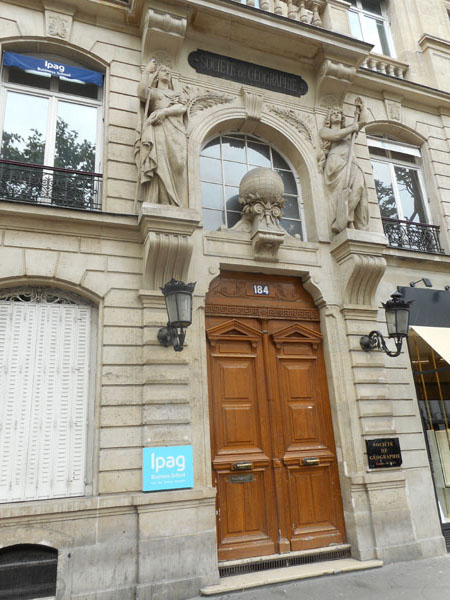 |
| crossing back onto Ile de la Citie we stop at Sant Chapelle |
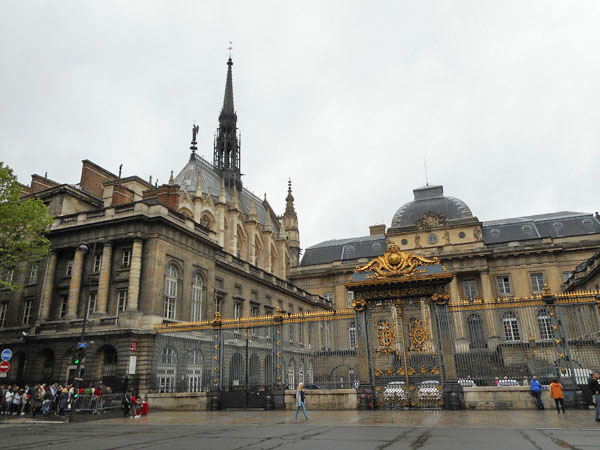 |
| The line for tickets and secuity screening (this is in the heart of French national judicial buildings) |
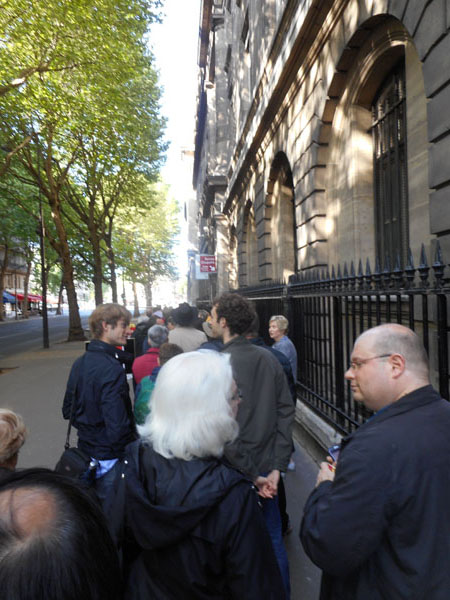 |
| Sate Chapelle on the left, the buliding of the highest level court in the country on the right |
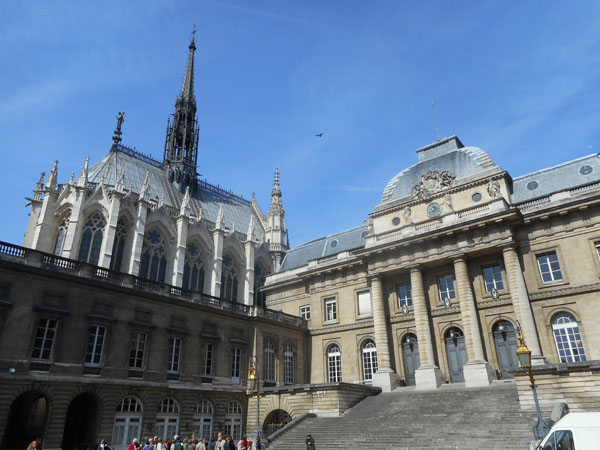 |
| |
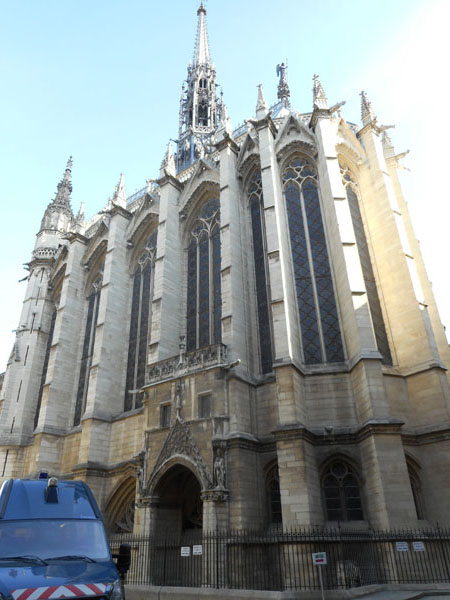 |
| |
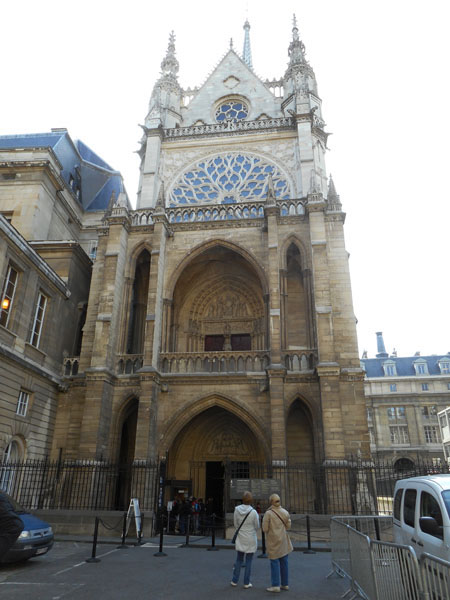 |
| The lower gallery meant for worshiping servants has been restored |
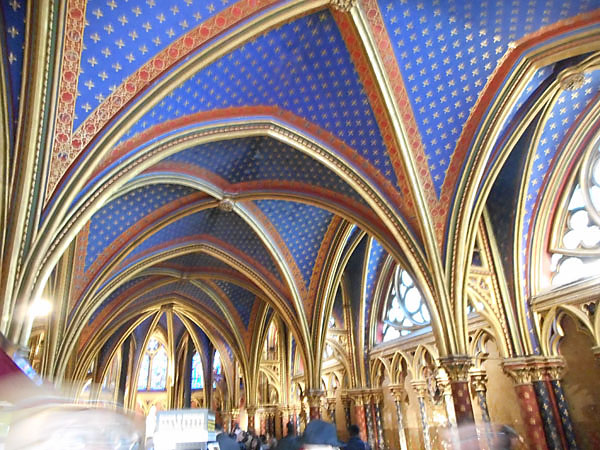 |
| |
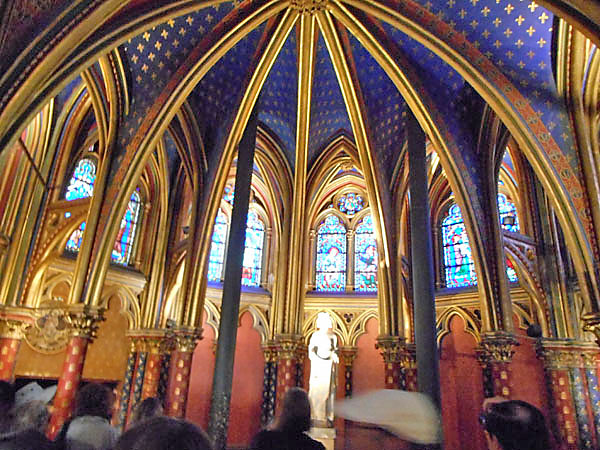 |
| but the reason people come here is upstairs |
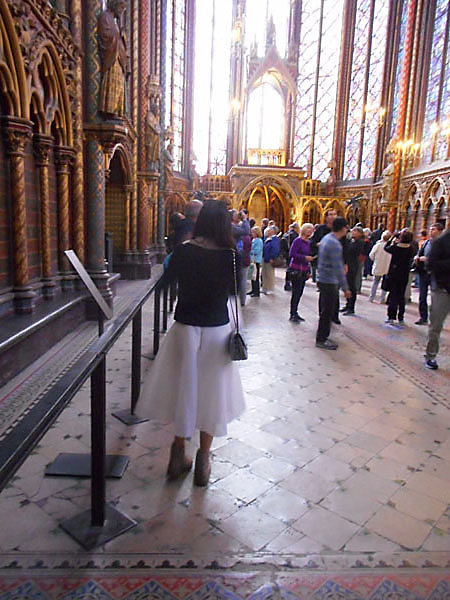 |
| Lots of amazing glass |
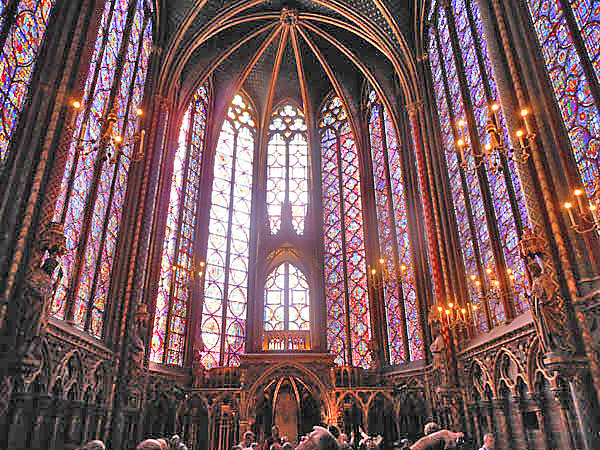 |
| |
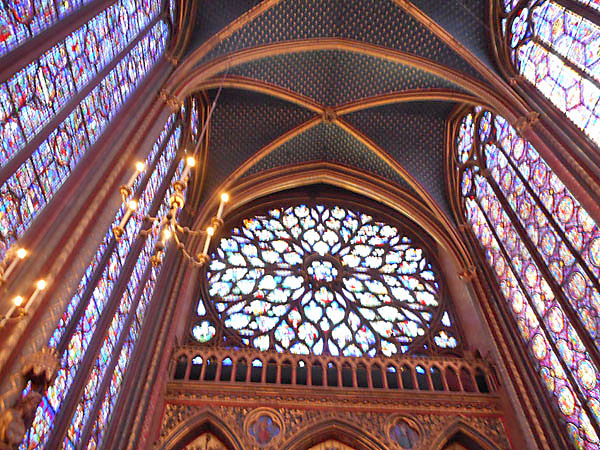 |
| |
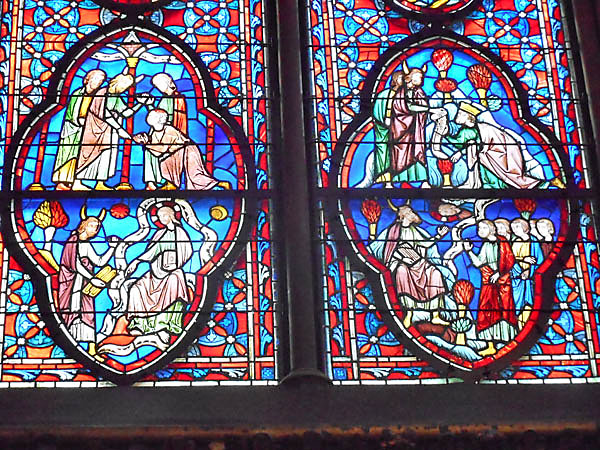 |
| |
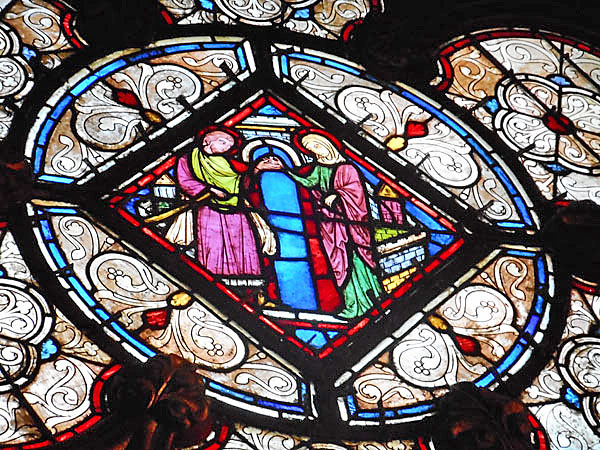 |
| Passing back out through secutity, we're back to where we started our loop. Our next loop goes north to the hill of Sacre Coeur and back |
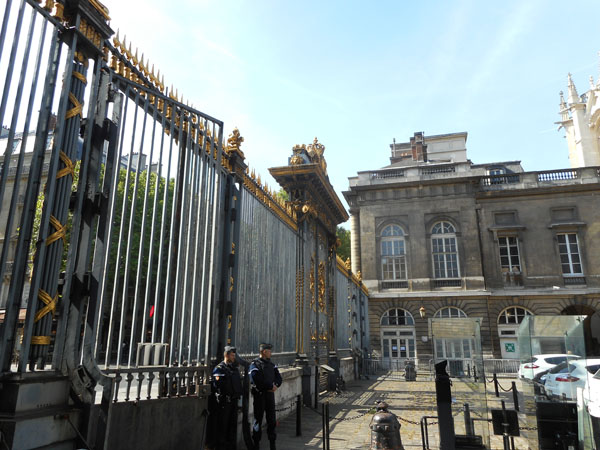 |
























































































































